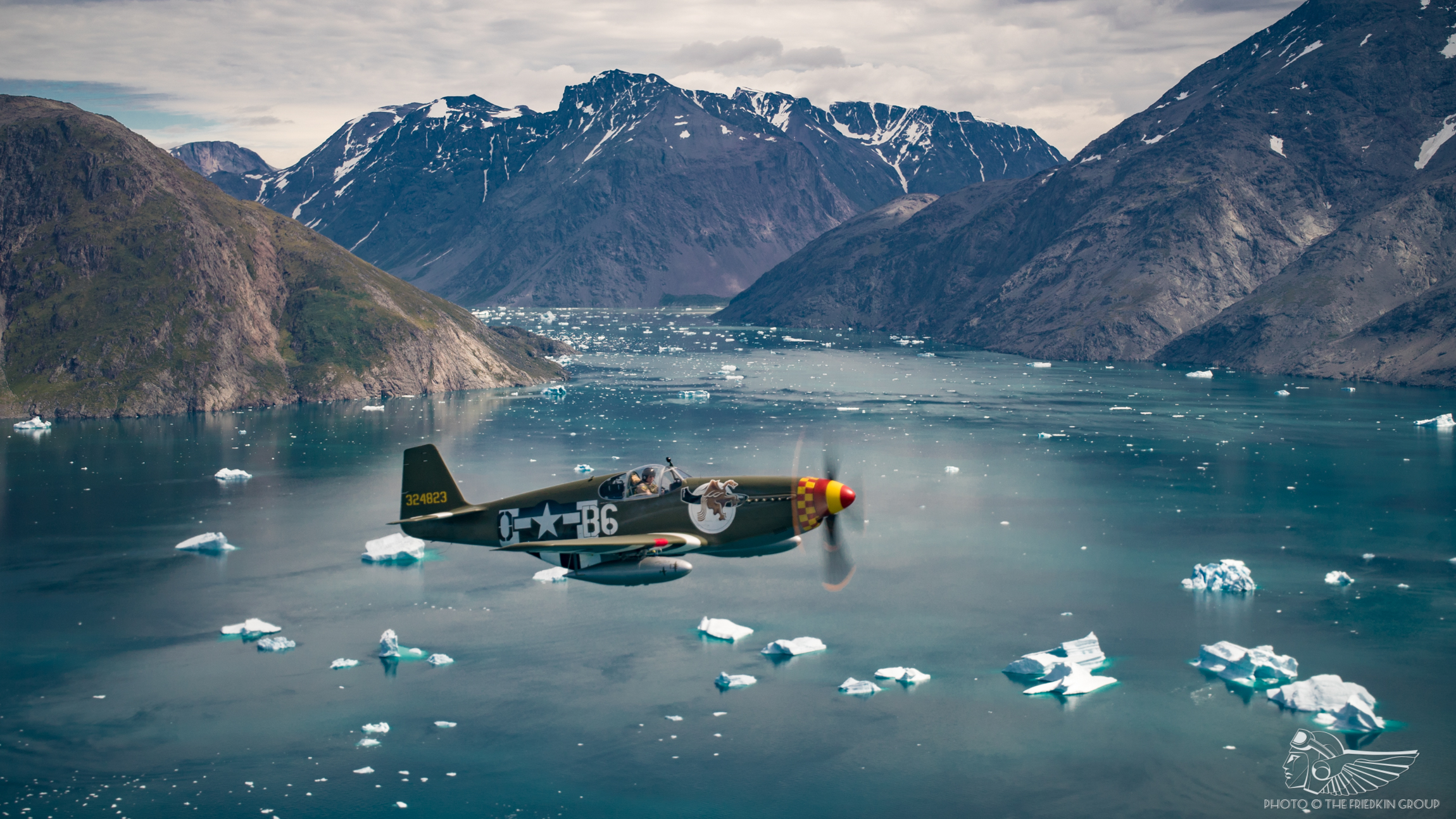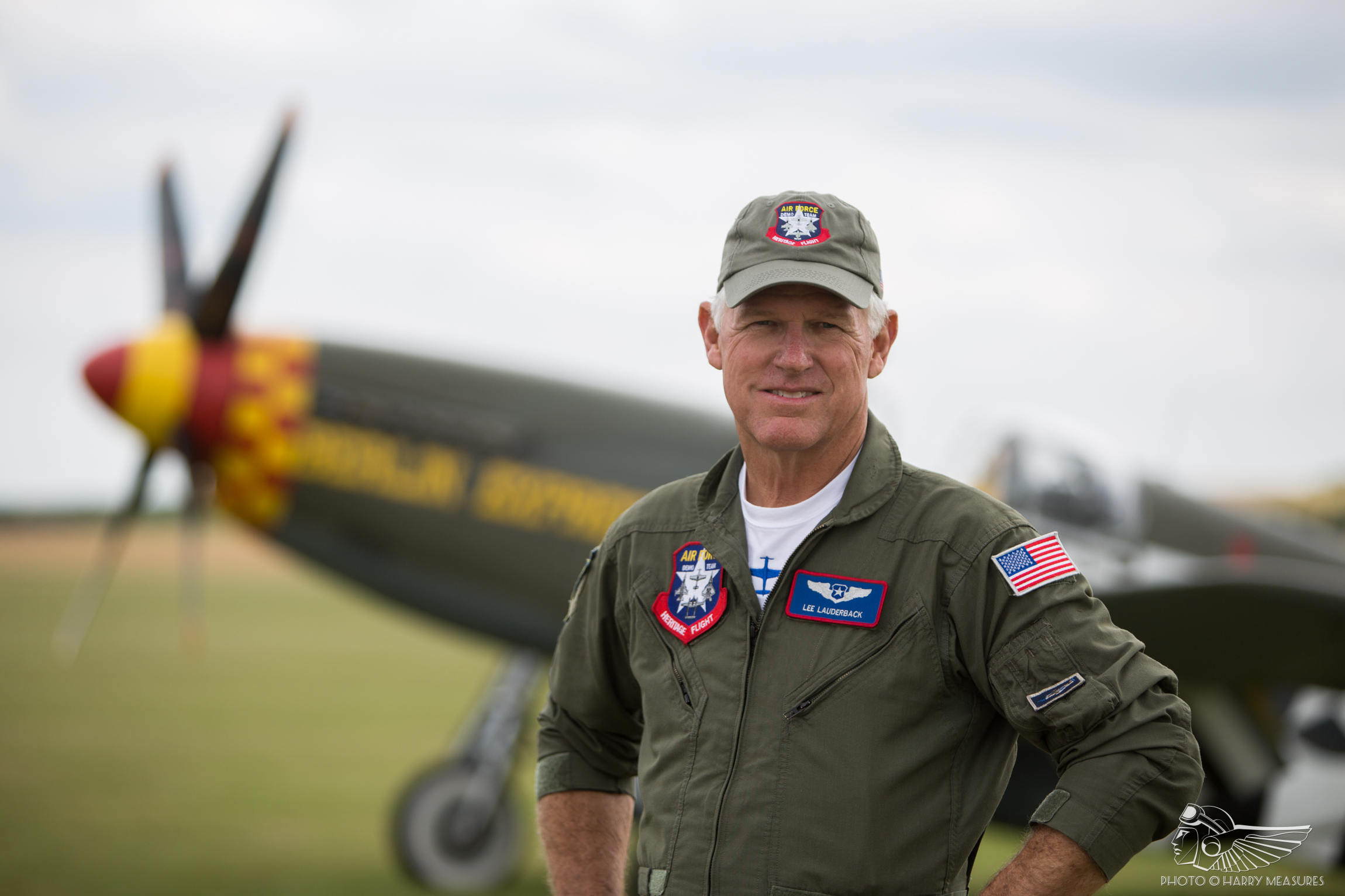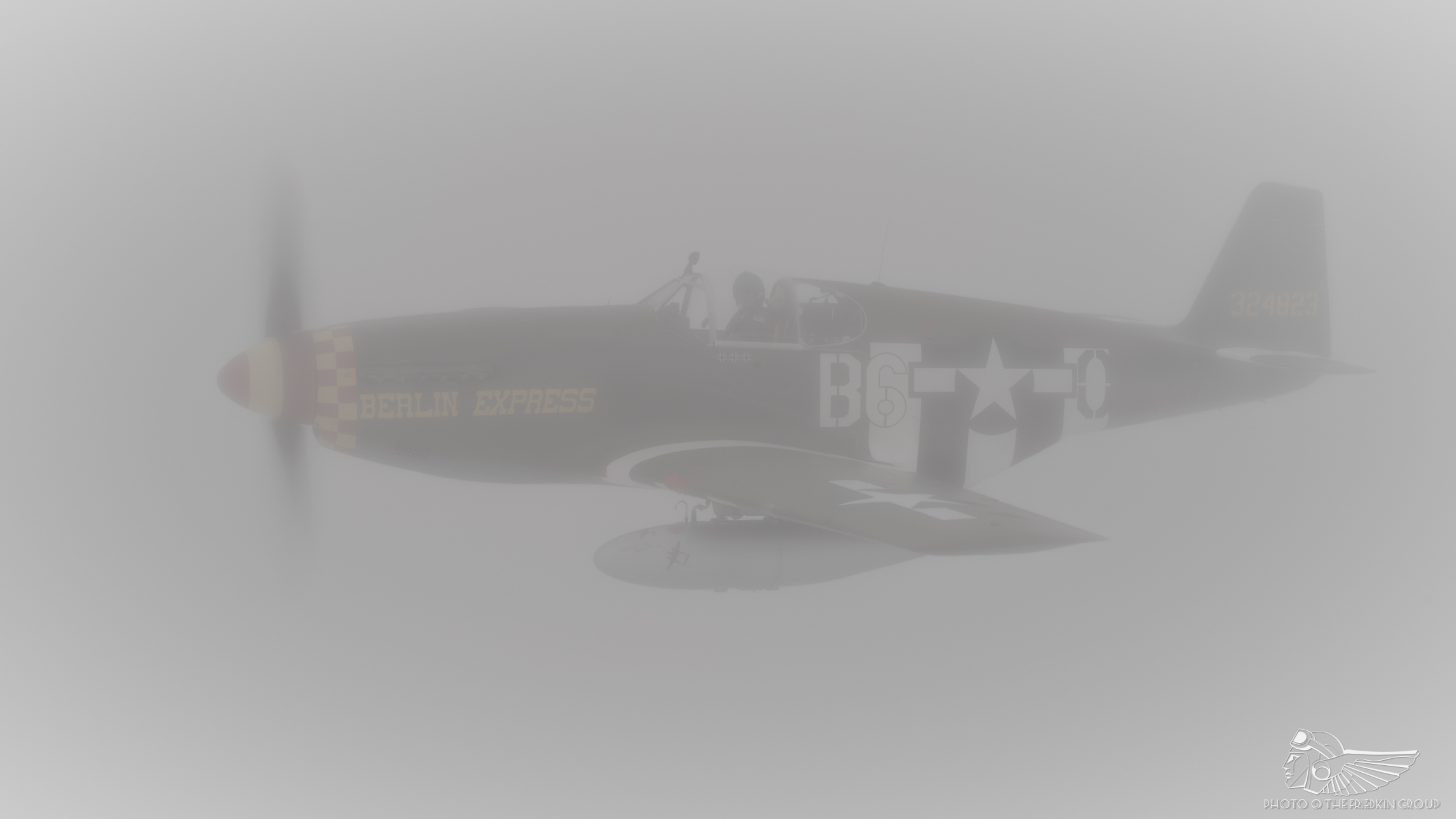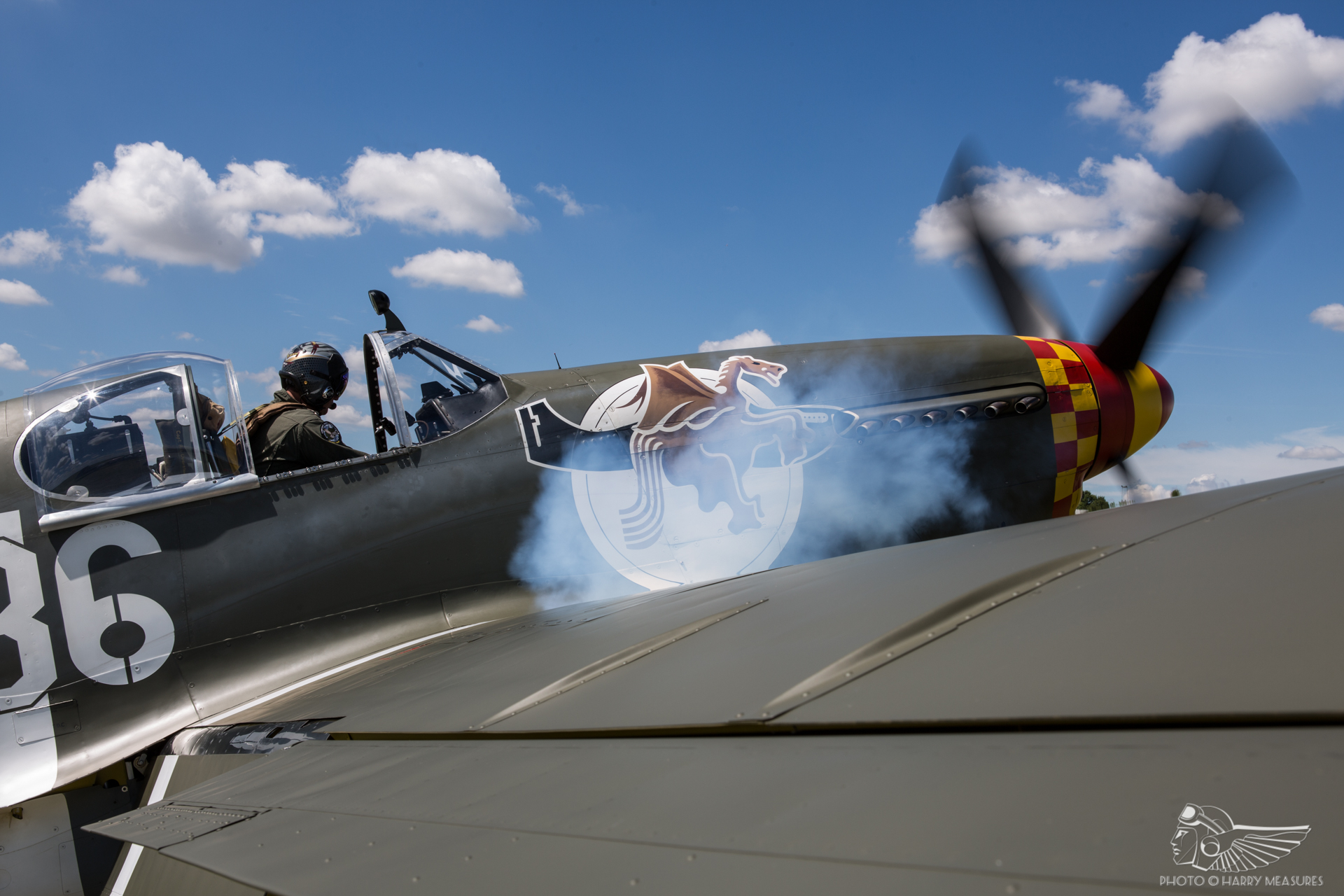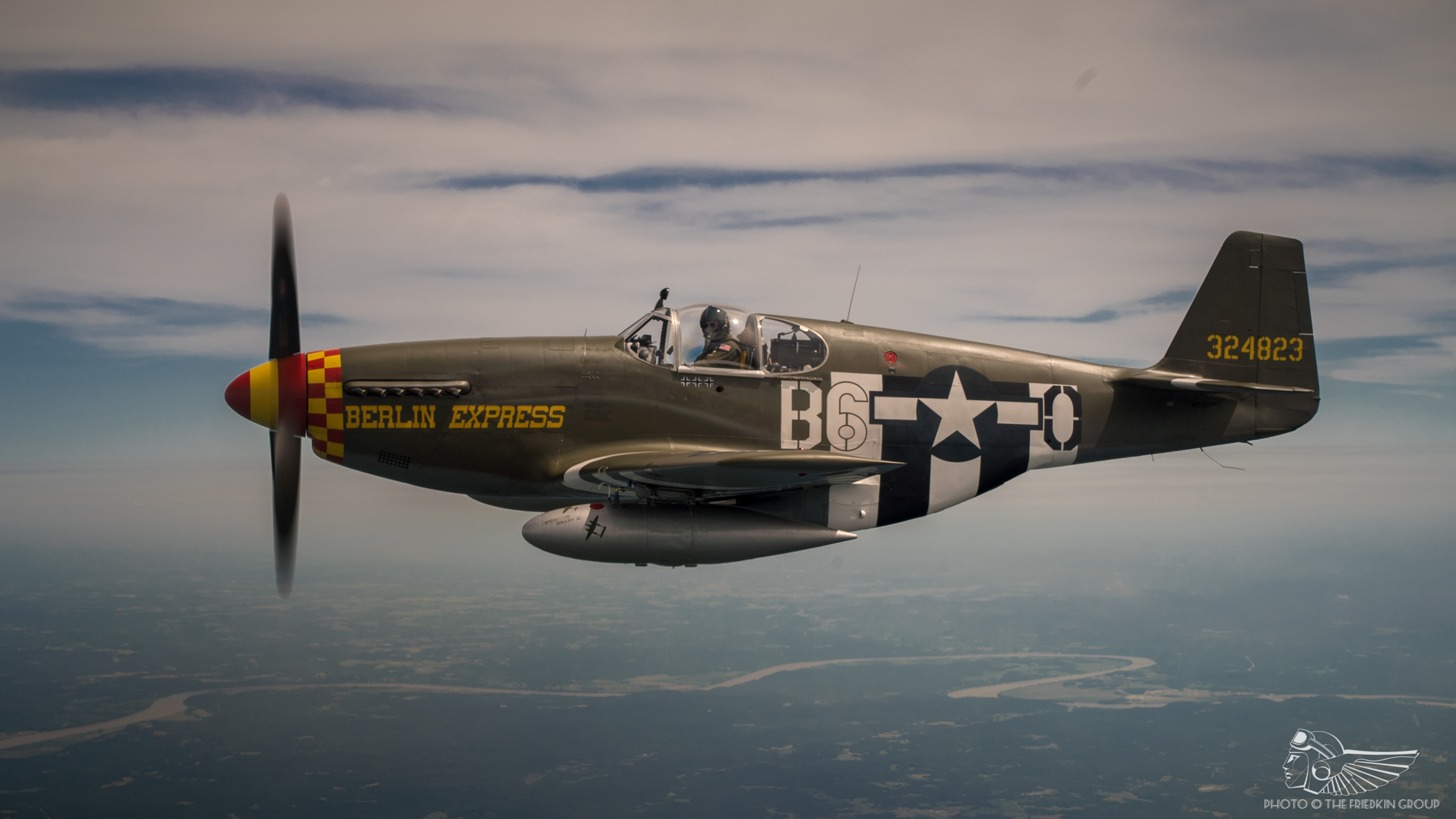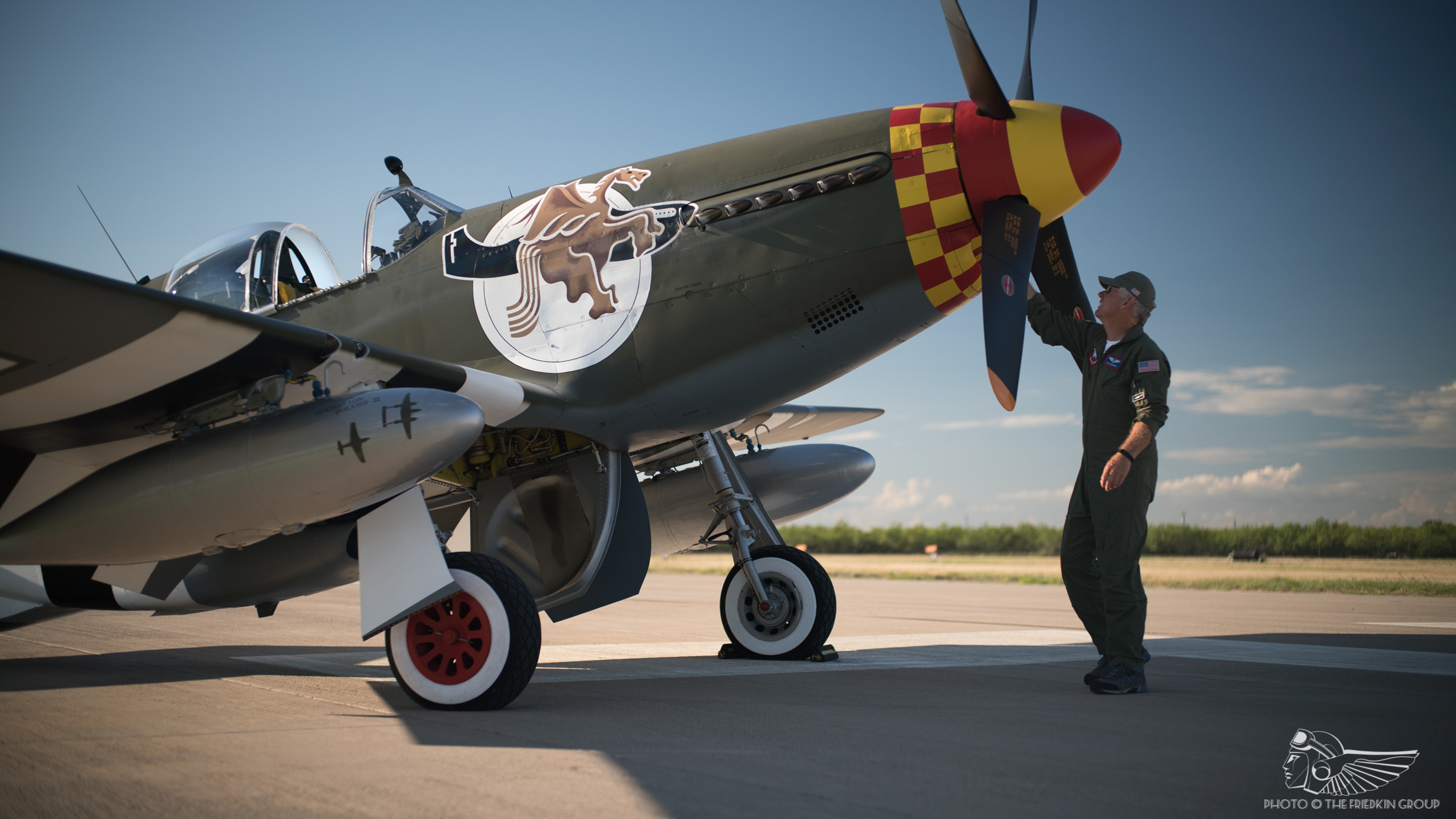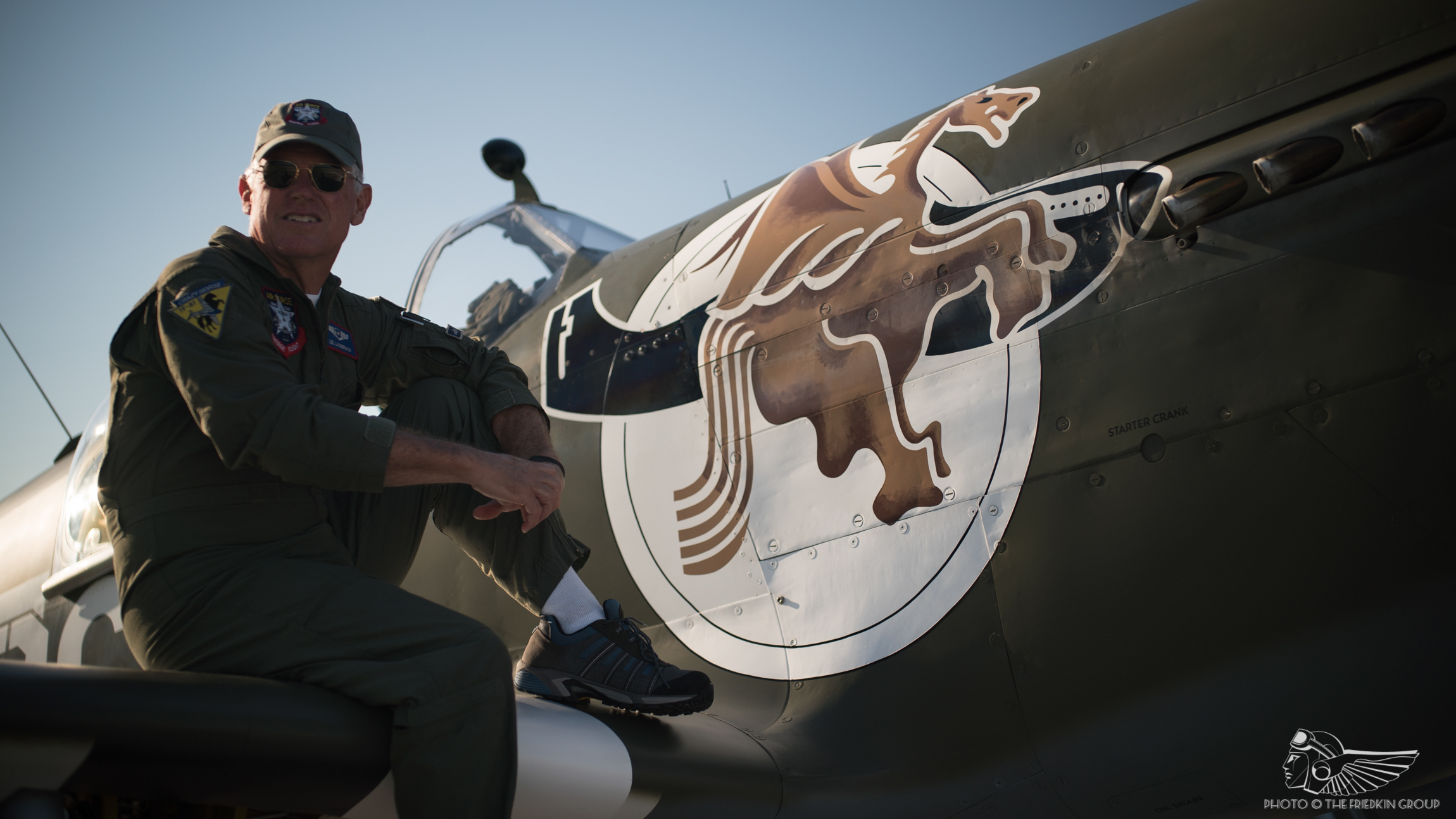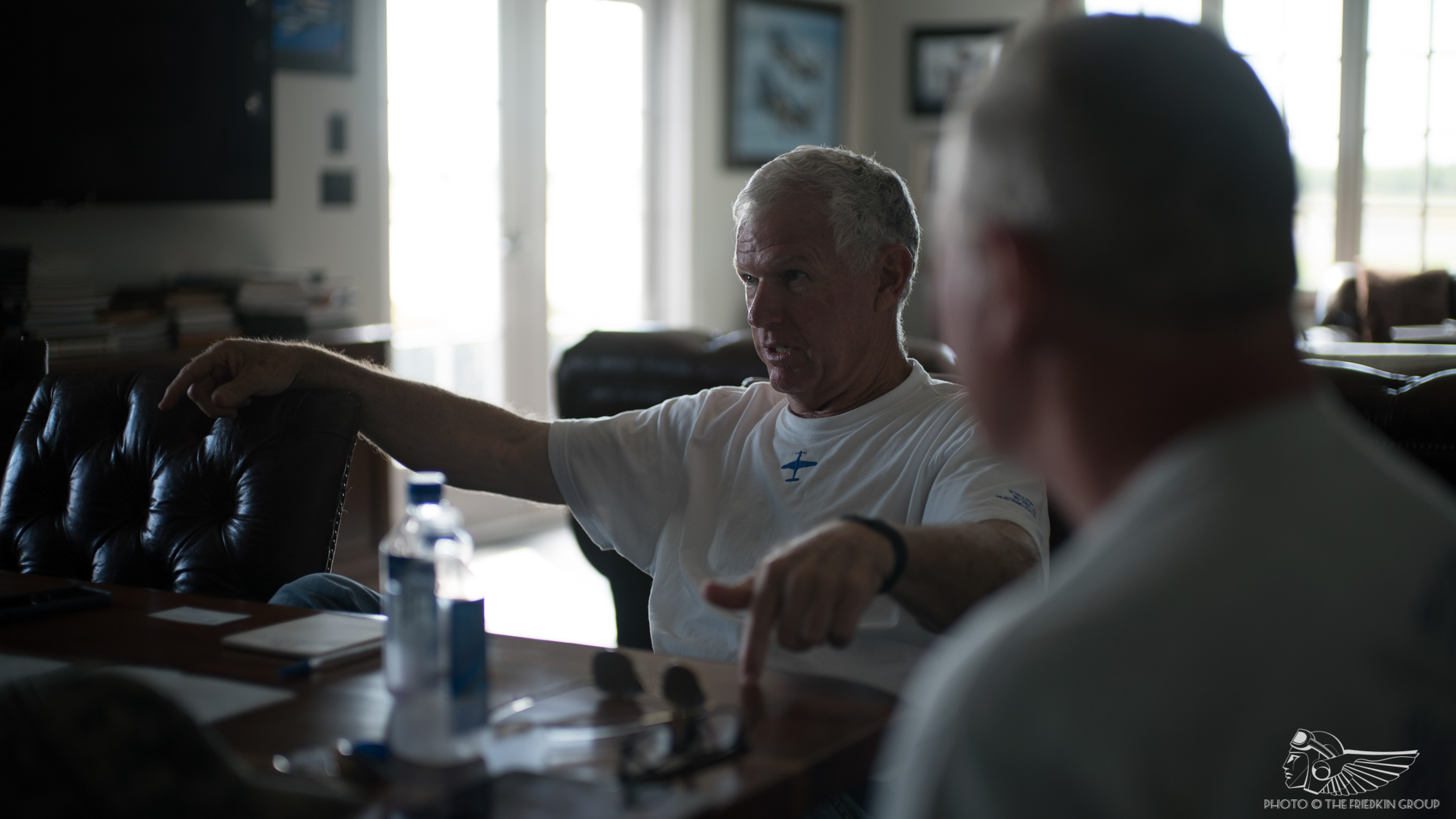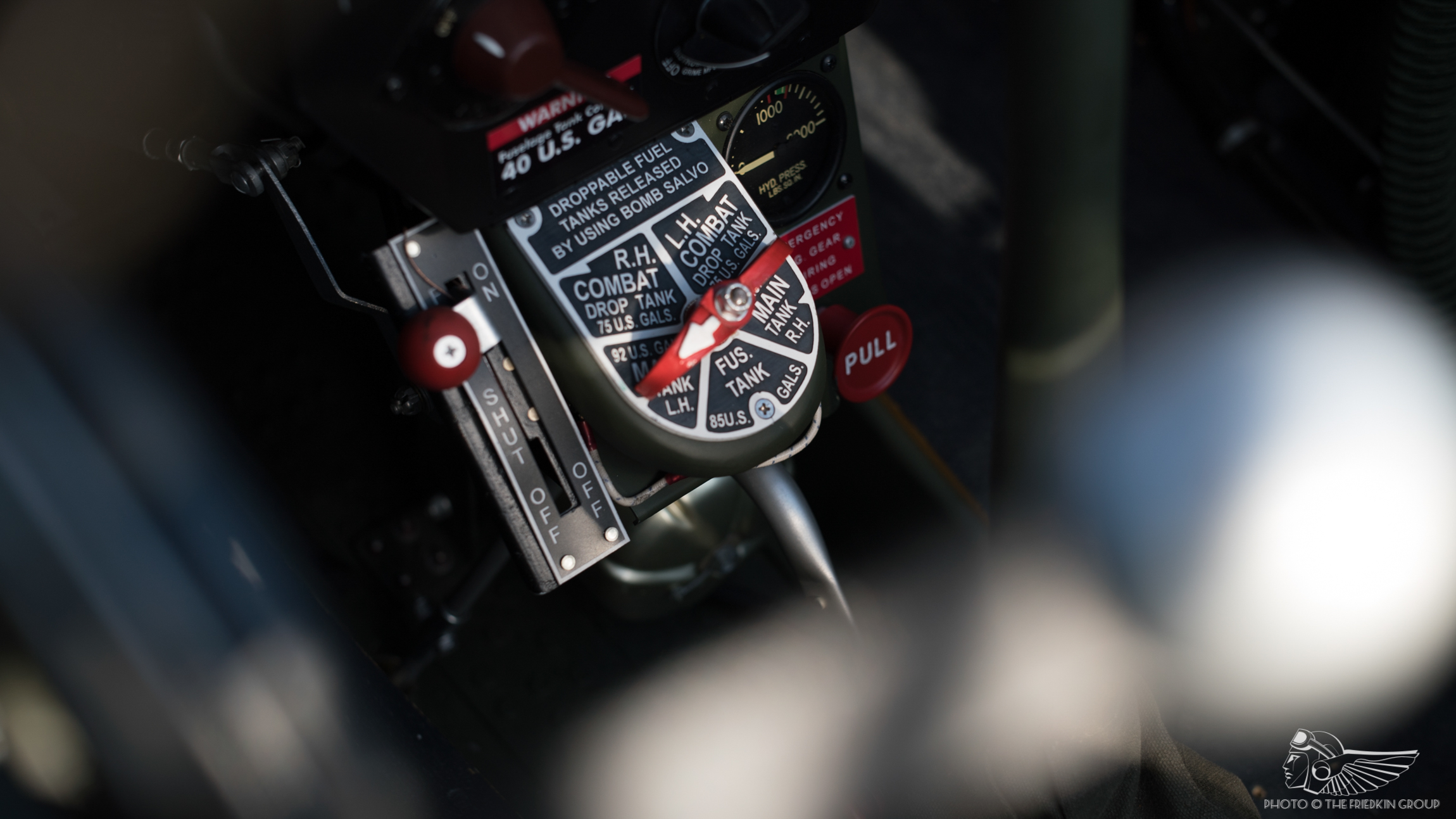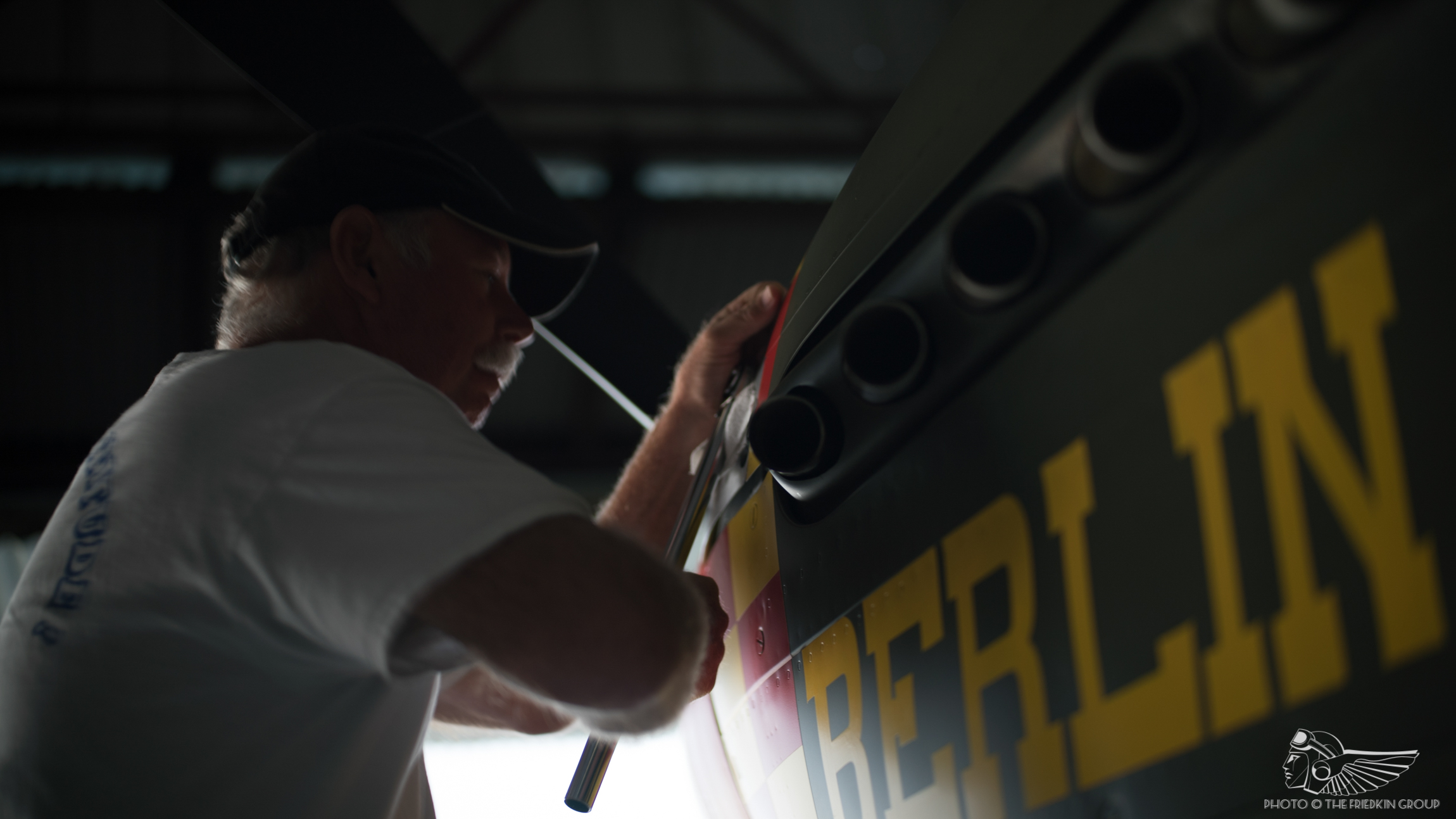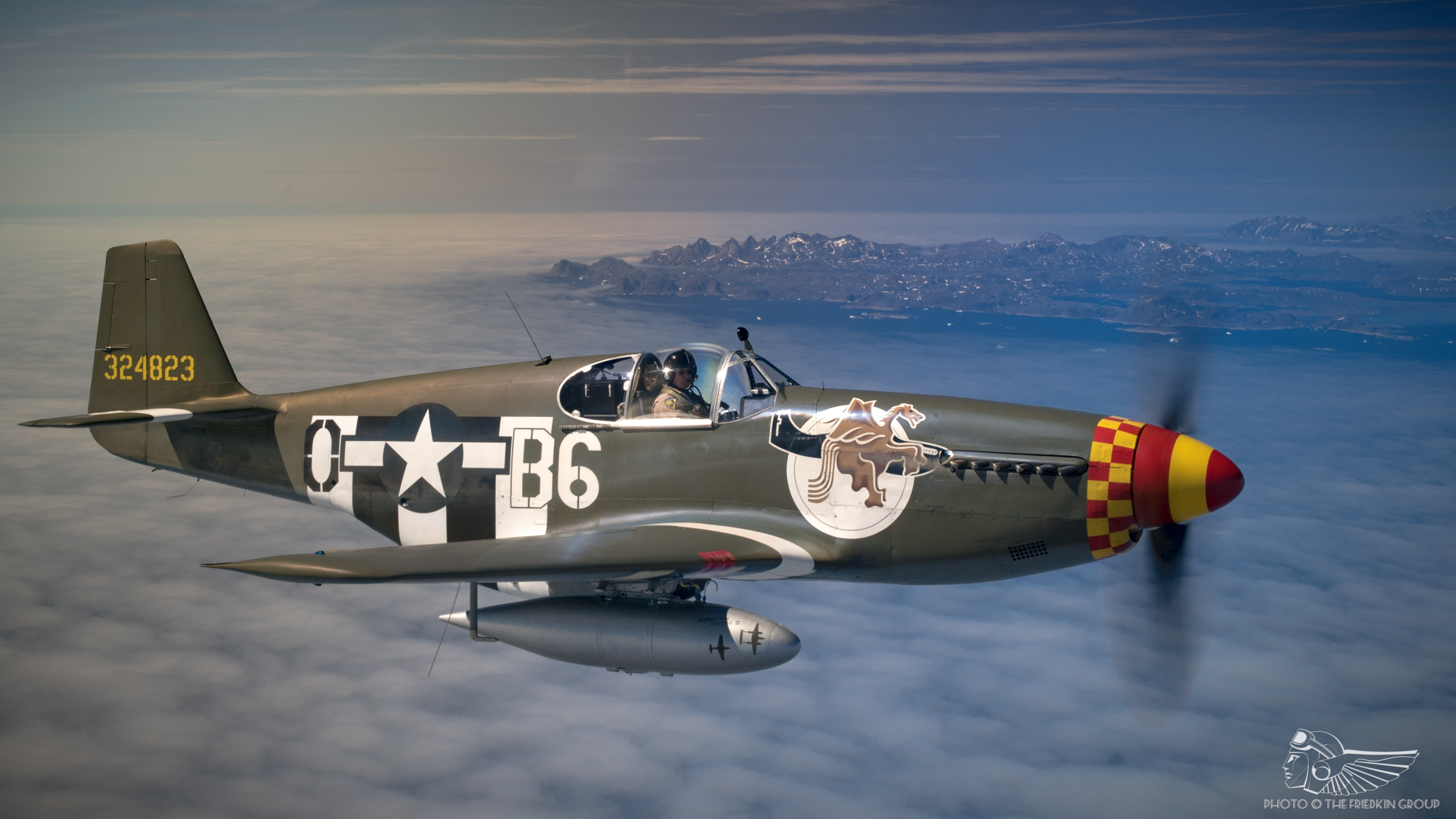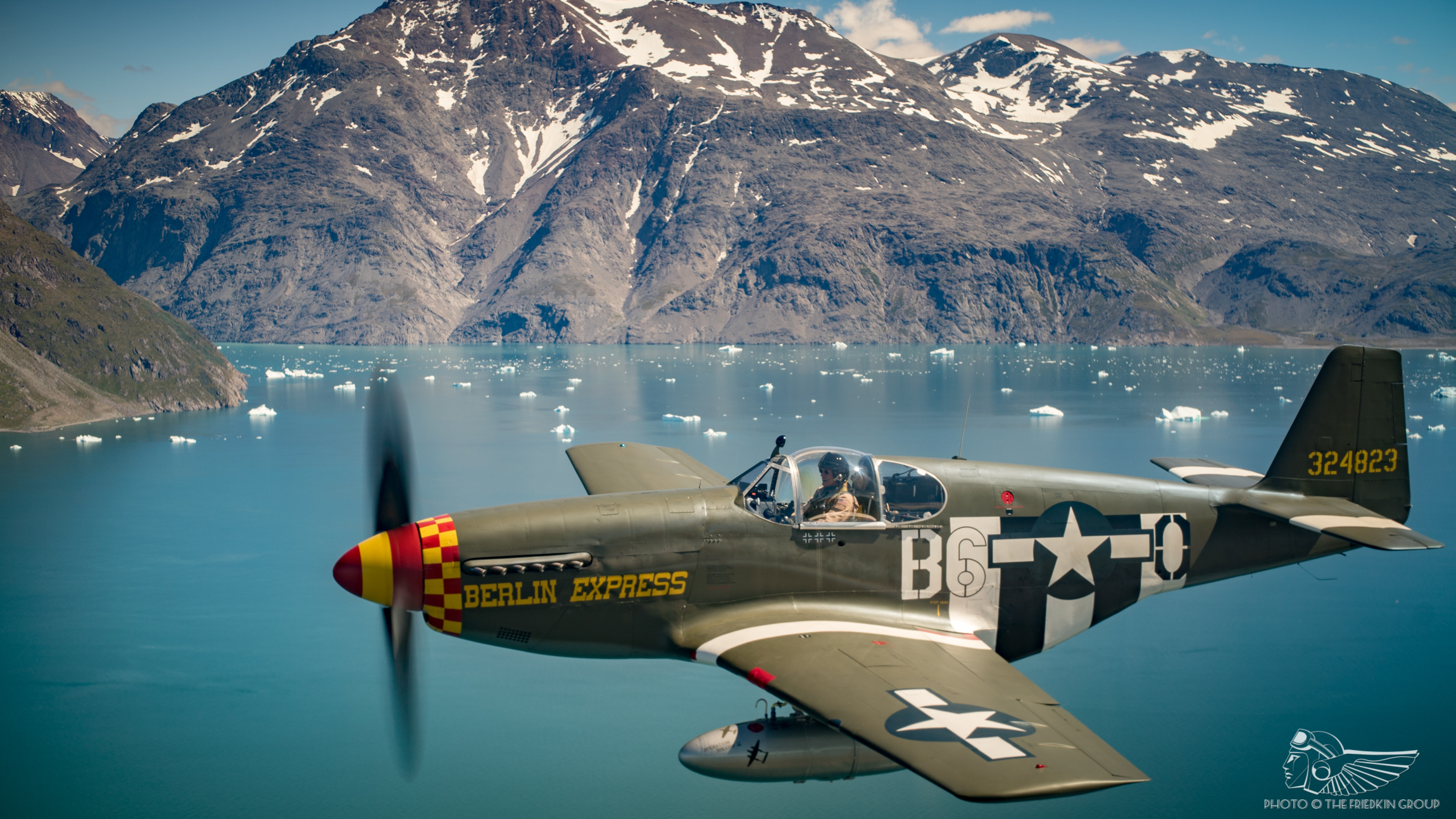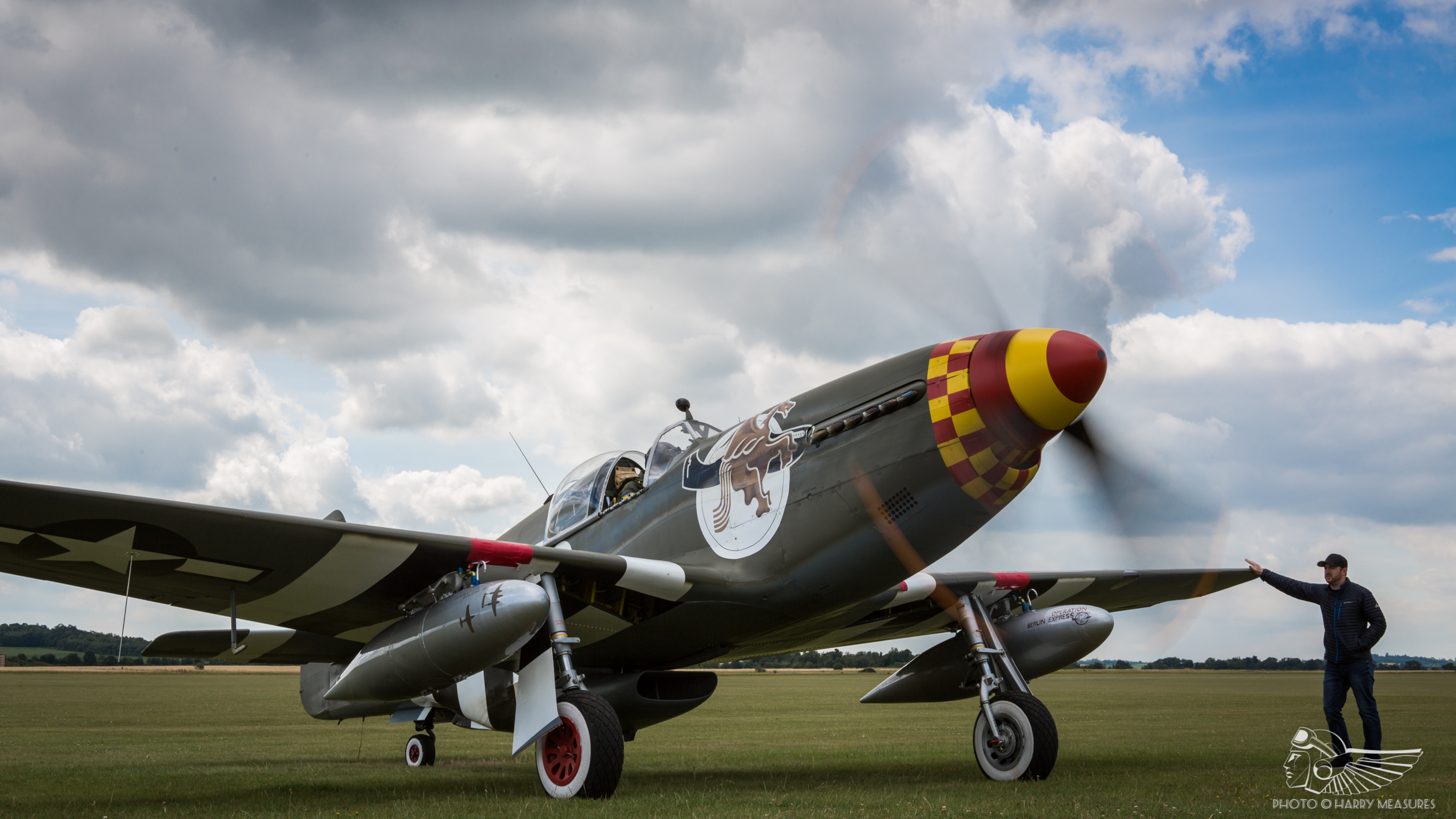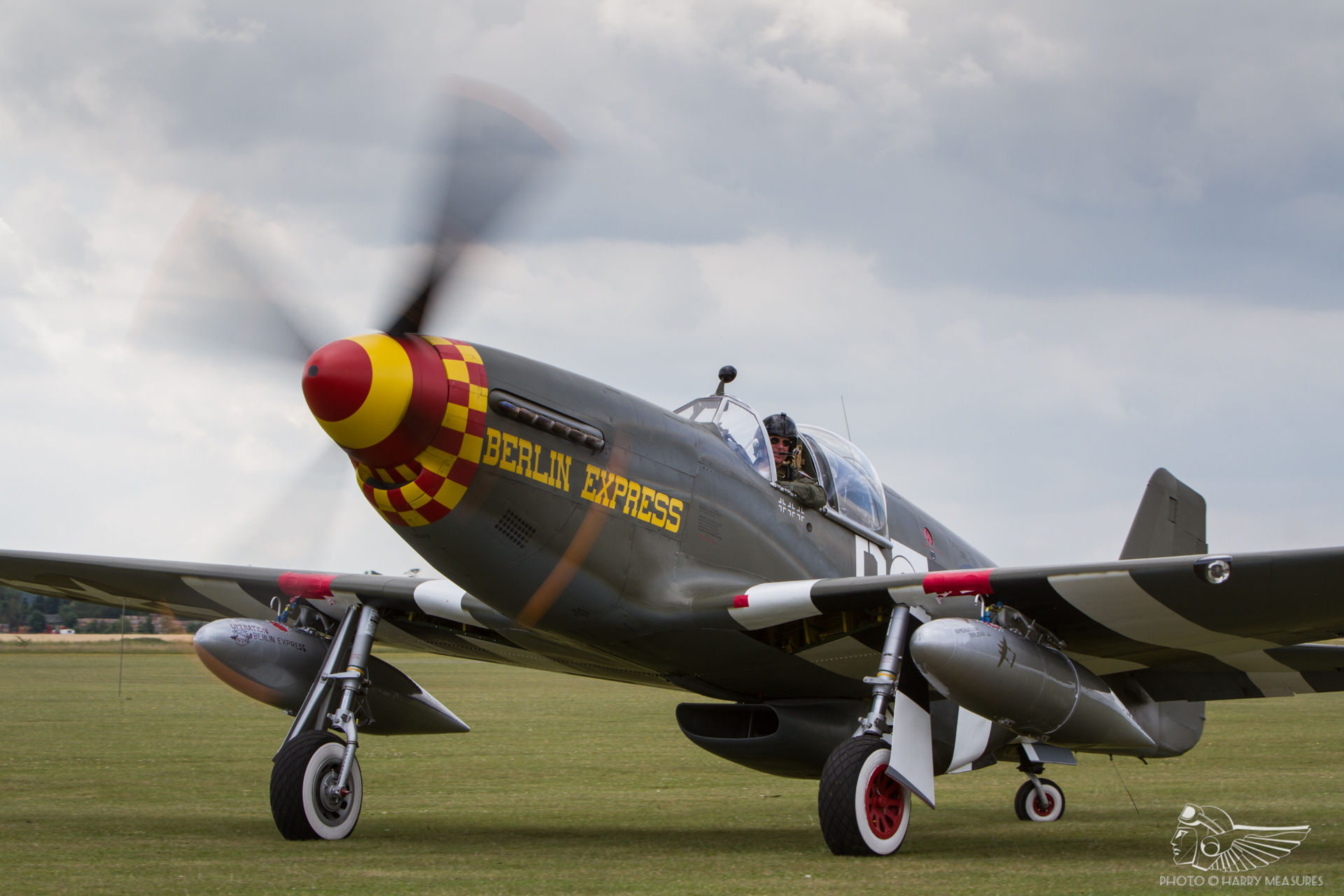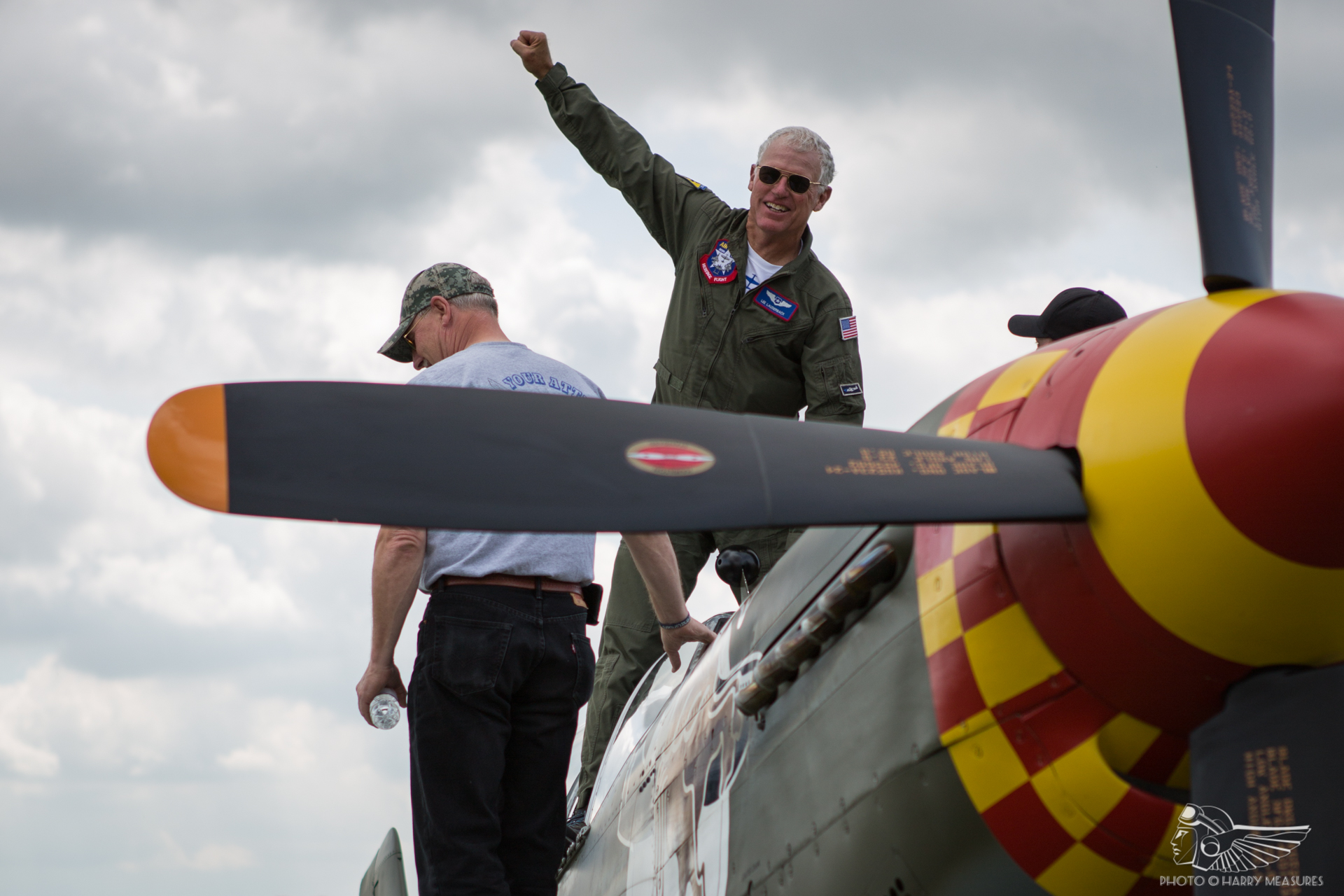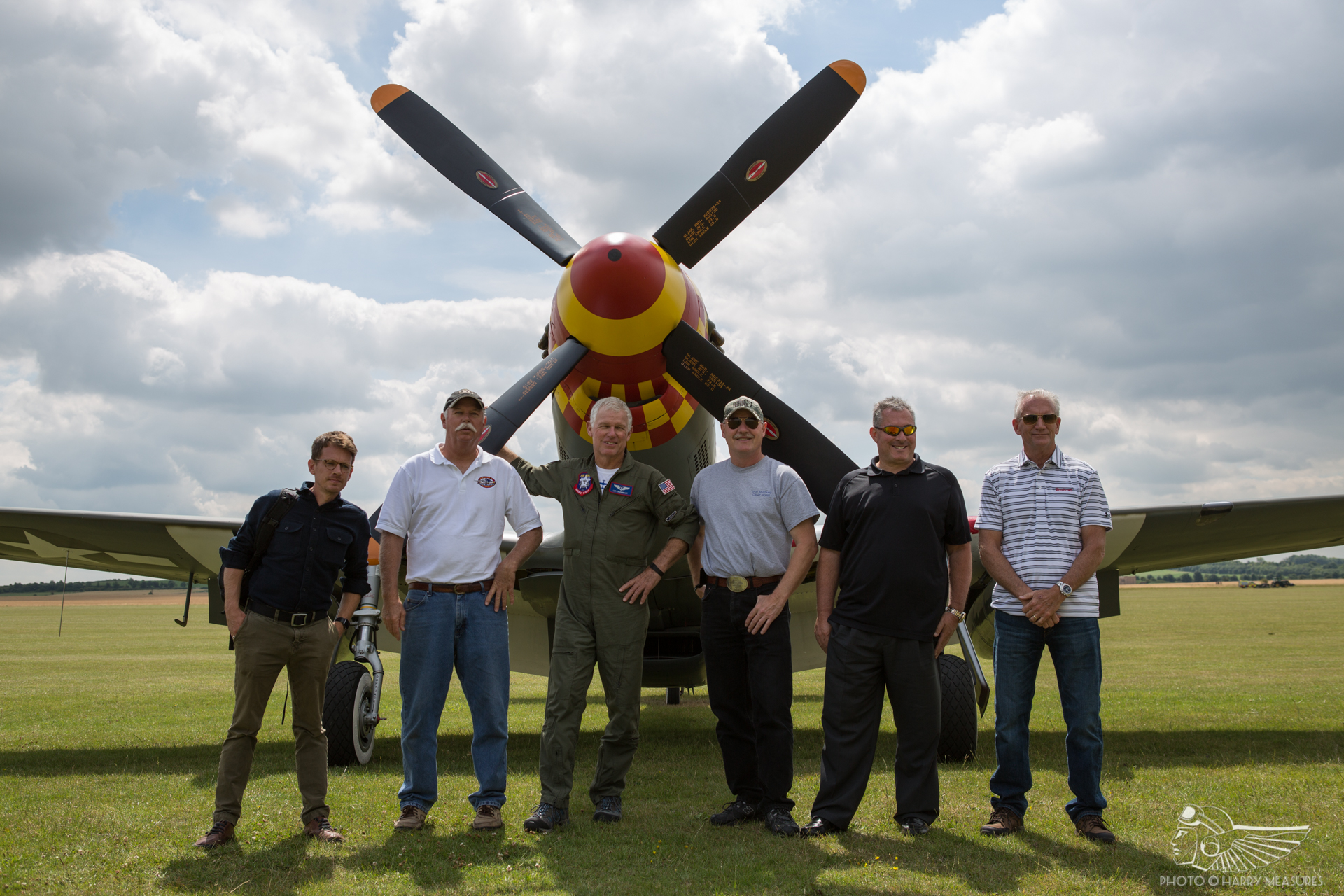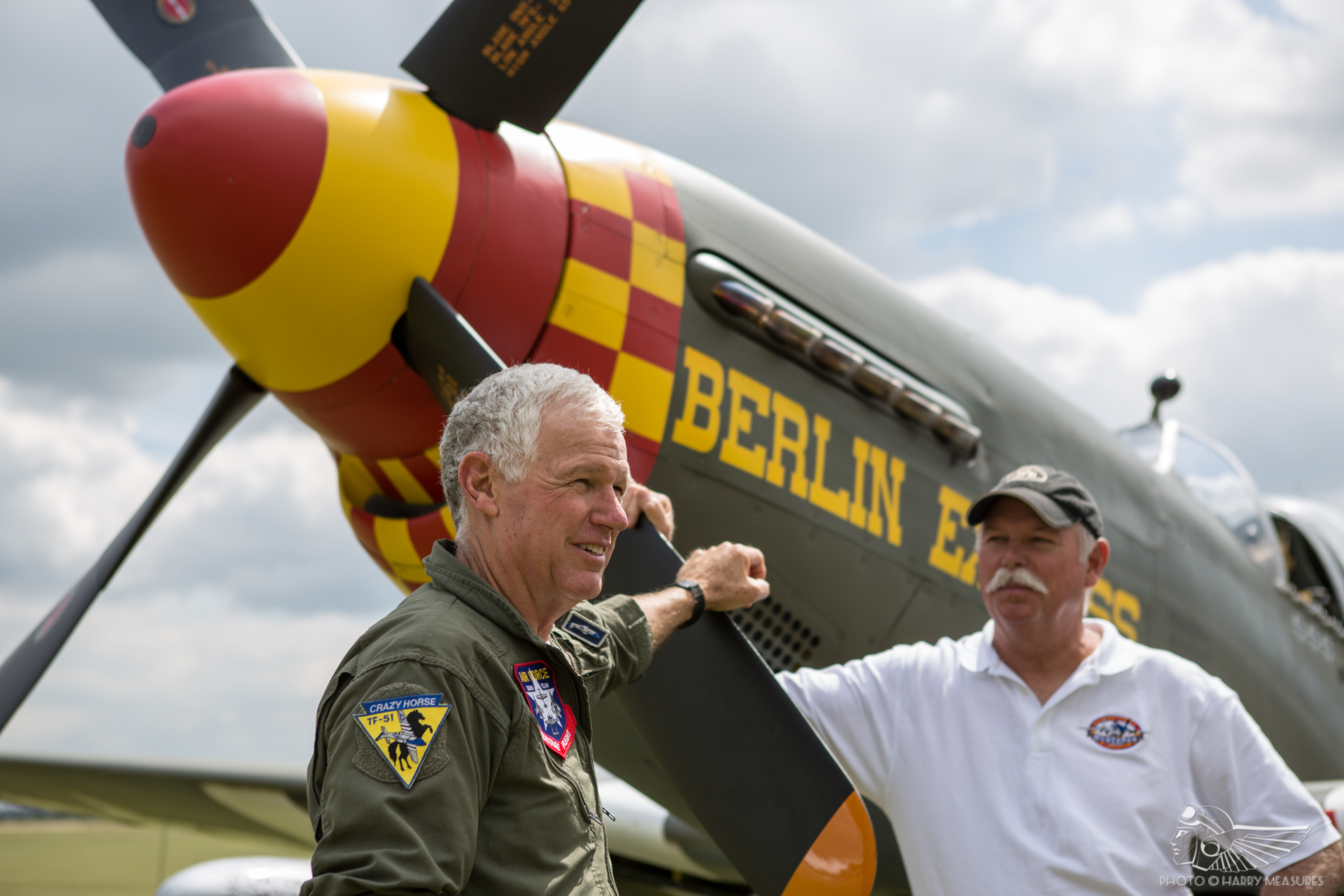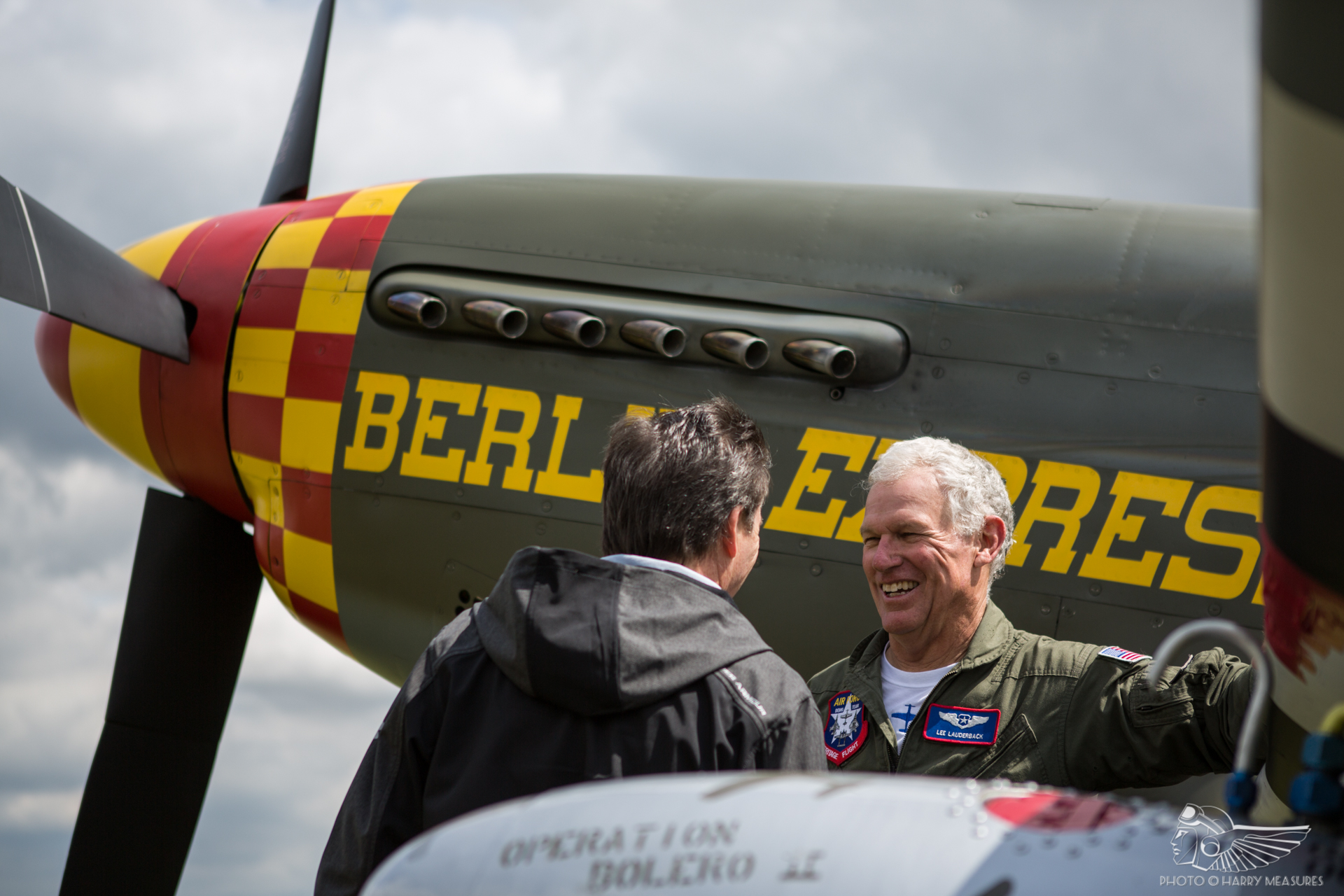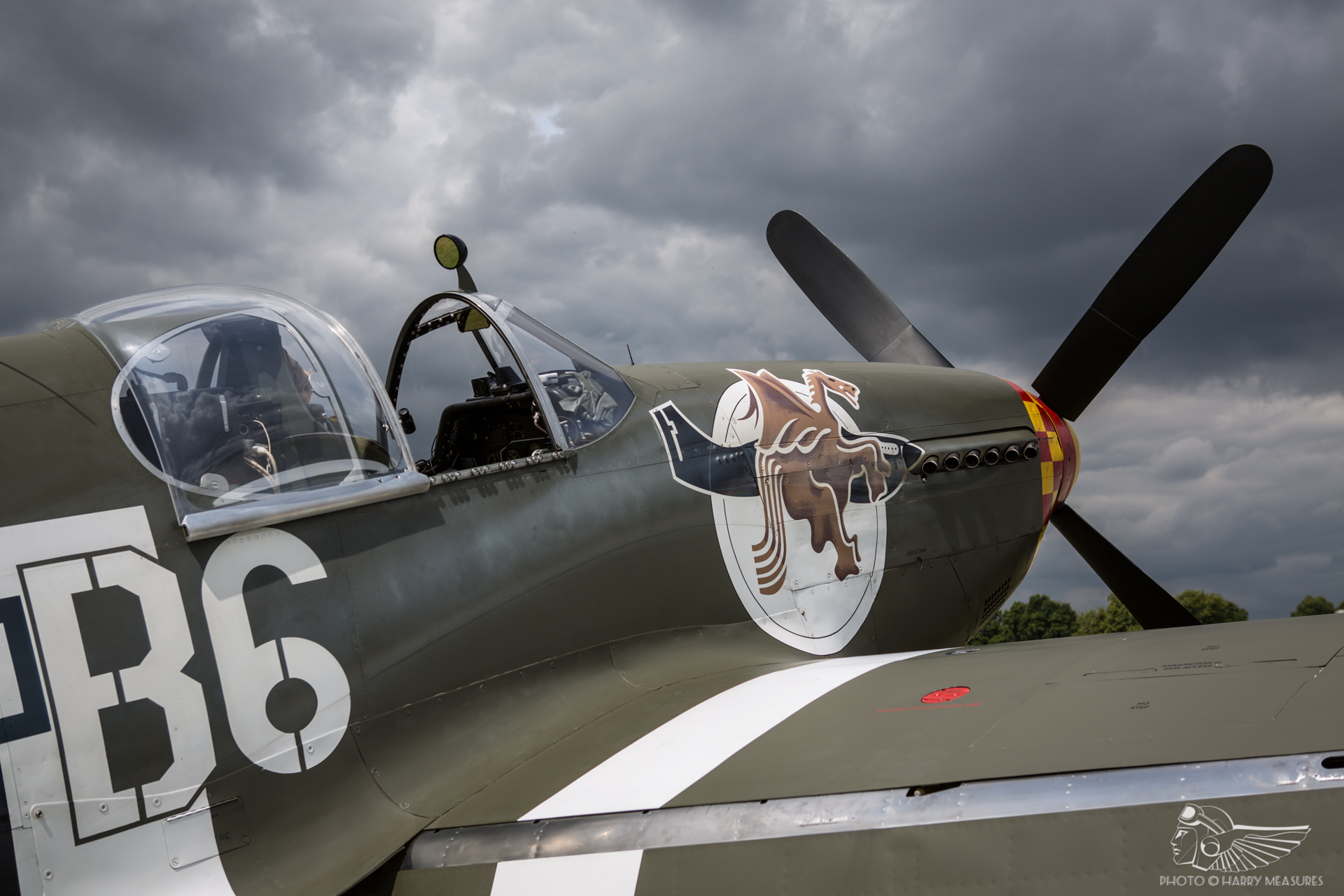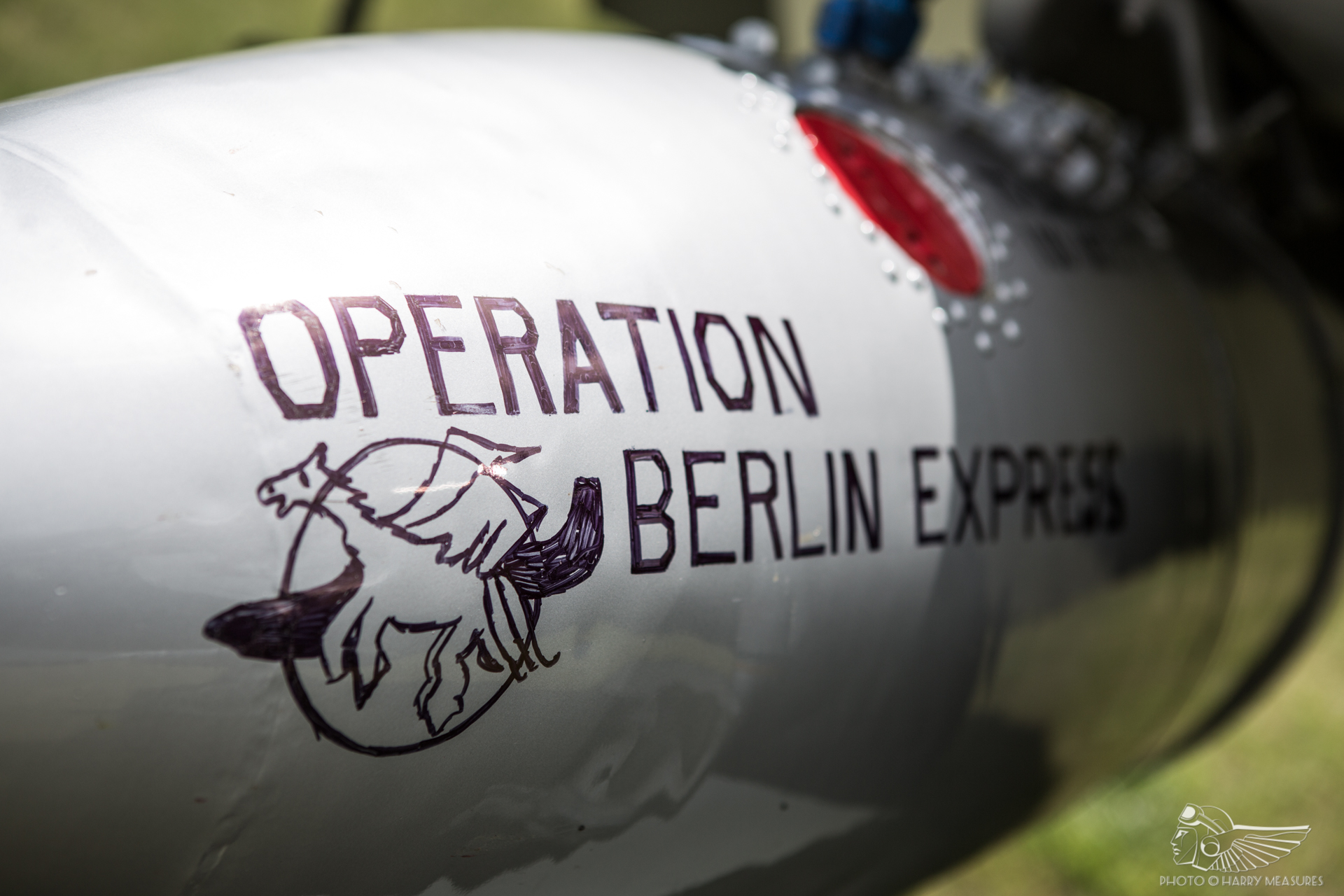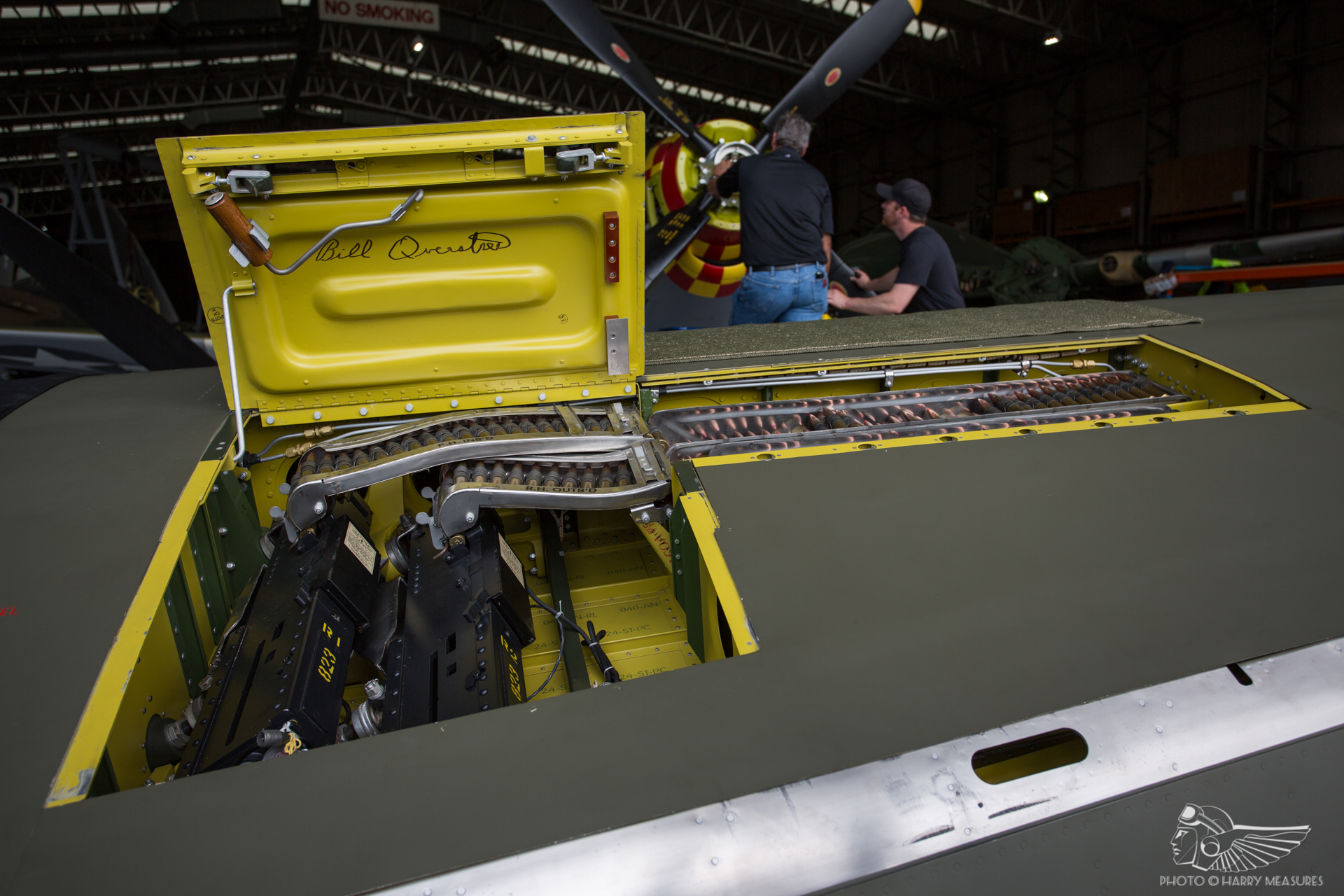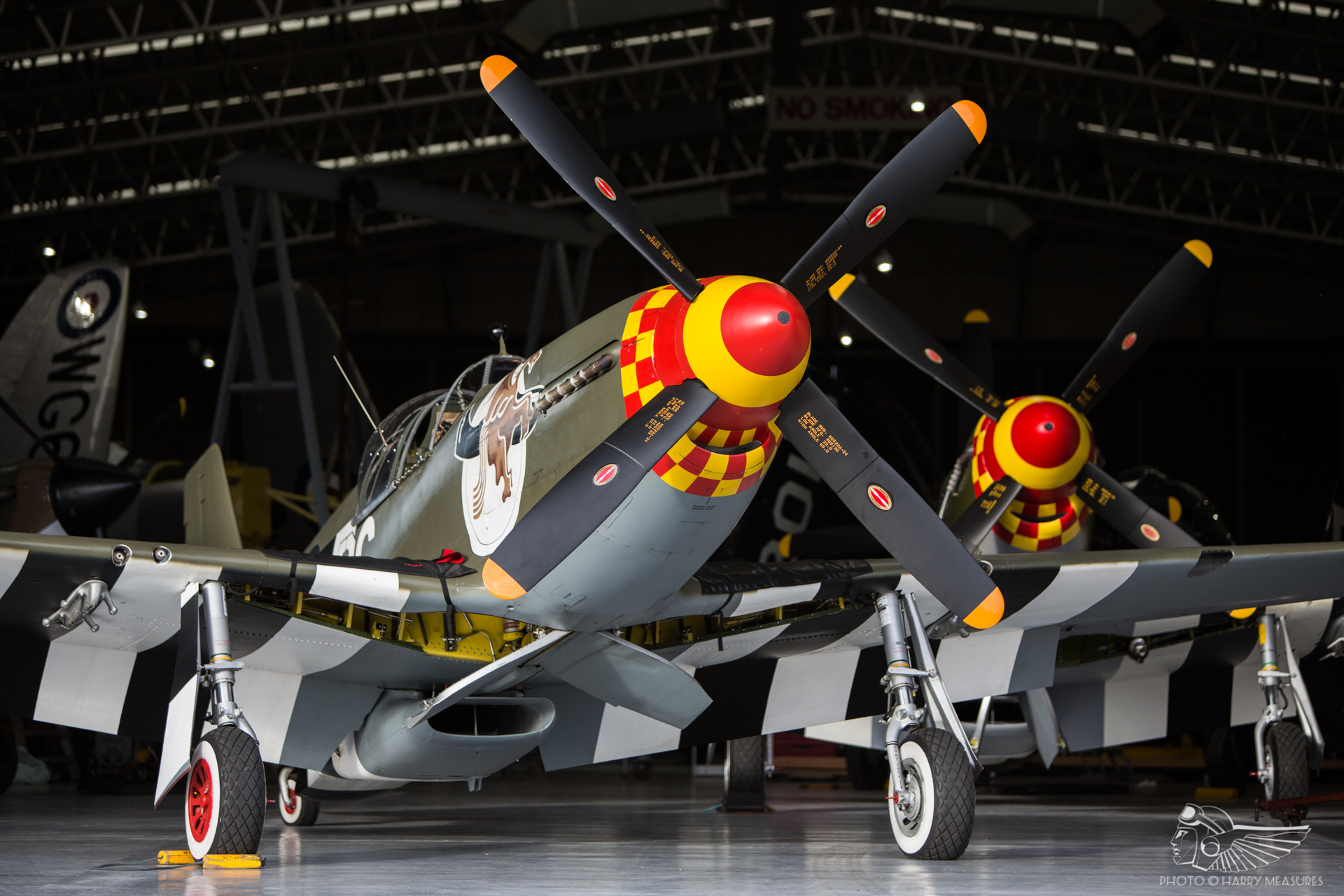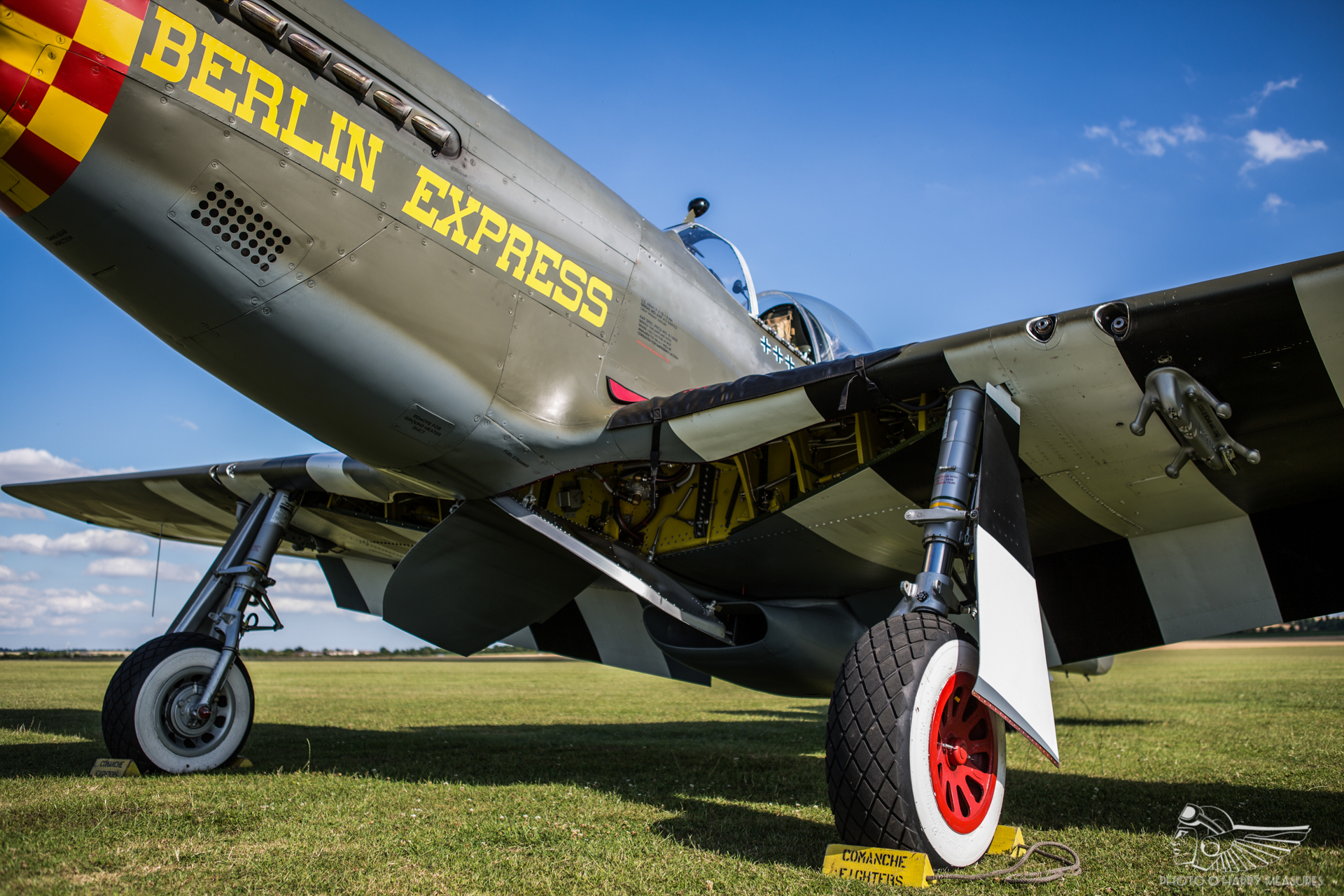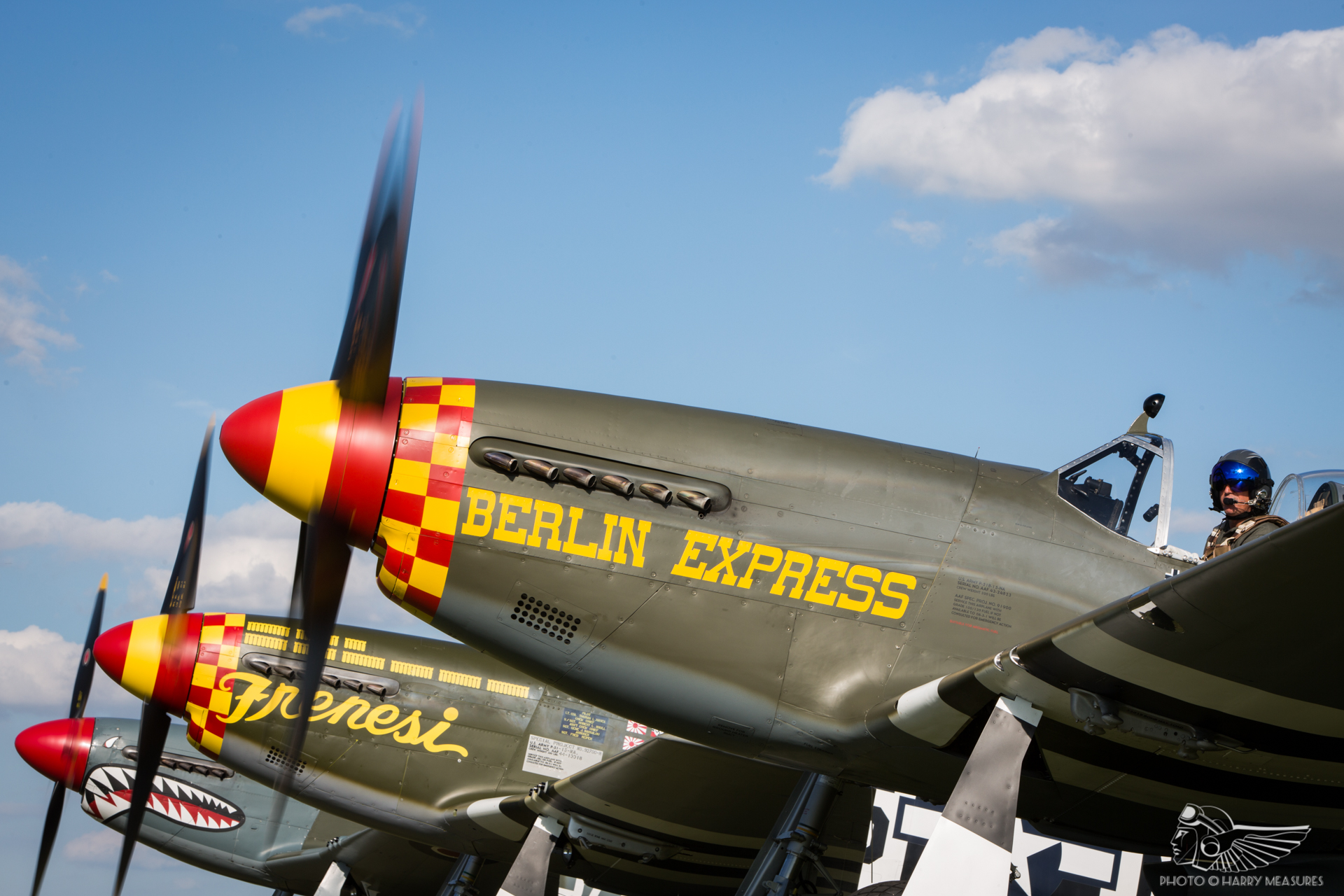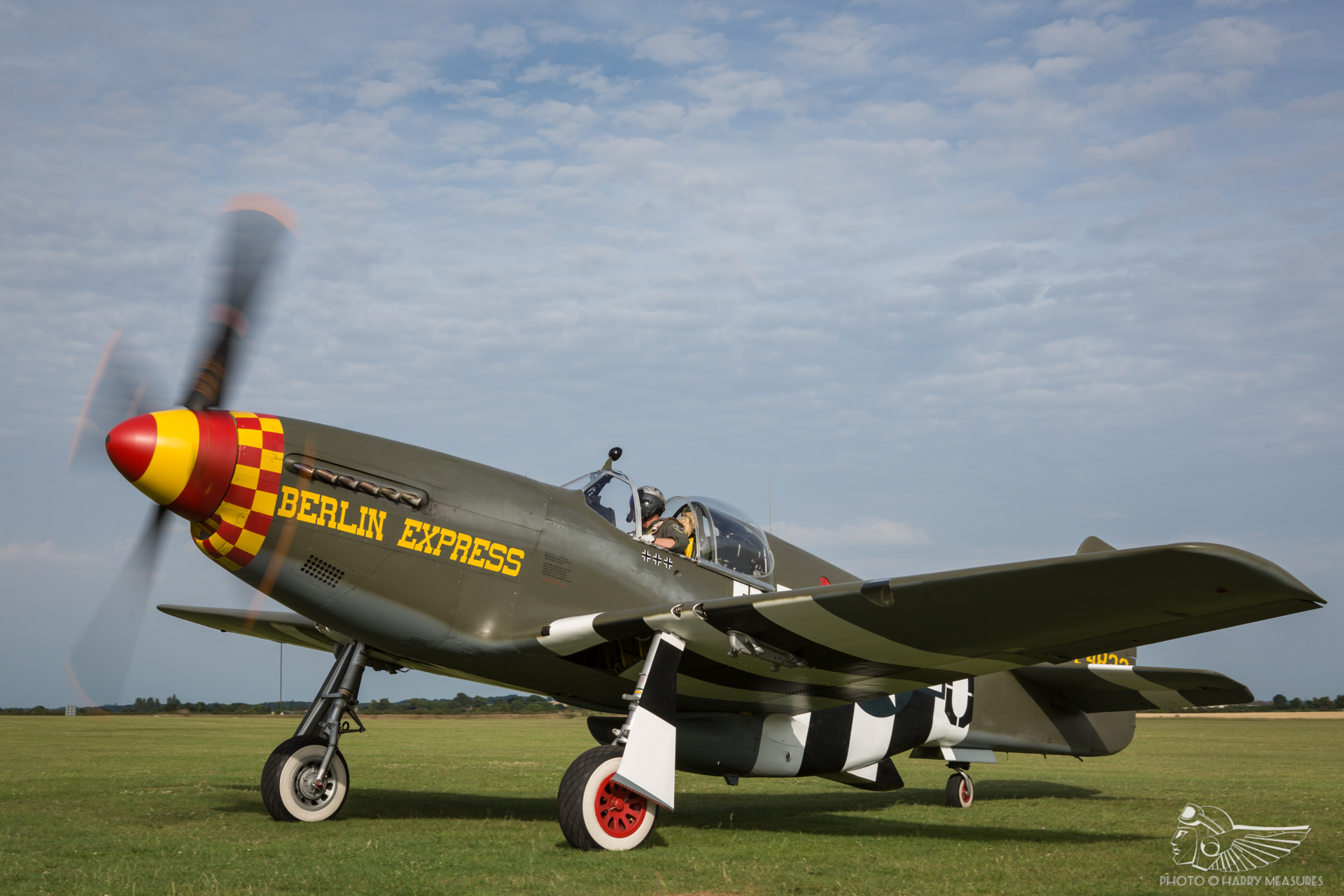Following Dan Friedkin’s acquisition of award-winning North American P-51B Mustang Berlin Express in summer 2017, plans were immediately set in motion to fly the aeroplane across the North Atlantic to the United Kingdom to participate in both the world-renowned Flying Legends airshow at Duxford and the Royal International Air Tattoo for a USAF Heritage Flight with the F-22 Raptor. With Dan’s aim of inspiring people around the globe, modern technology and social media were utilised to broadcast the Mustang’s 4,775 nautical mile transatlantic journey to the world, allowing those at home to monitor Operation Berlin Express in real time.
Entrusted with flying Berlin Express from Texas to Duxford was Stallion 51 Corporation’s owner and chief pilot Lee Lauderback, the most experienced Mustang pilot in history with more than 9,500 hours logged on type.
“I’d kidded Ed Shipley about flying a single engine warbird across the Atlantic when he was enlisted to ferry Miss Velma to the UK”, Lee recalls with a knowing smile. “When Dan acquired Berlin Express, Ed said, ‘Hey, remember me flying the Mustang over to Duxford in 2007? Do you have any interest in doing it this time?’ I said, ‘After harassing you so badly, not really!’ He asked whether with the right team of people and the right resources, I might consider doing it – I gave it some thought and after discussing the logistics and resources, agreed to ferry the Mustang from Texas to Duxford.
“The only shock was that I thought Ed was talking about Flying Legends 2018 – not the airshow in three weeks’ time!”
The proposed eight-leg flight plan called for Berlin Express to depart South Texas on 28 June 2017. From there, the Mustang would route via four waypoints in North America before crossing the Atlantic Ocean via Greenland and Iceland, with arrival at Duxford planned for 4 July – Independence Day. Broadly, Berlin Express’ journey would echo the North Atlantic air ferry route flown by thousands of United States Army Air Force (USAAF) combat aircraft during Operation Bolero, the build-up of Allied materiel in the European Theatre of Operations (ETO) in advance of the invasion of occupied Europe.
Transatlantic ferry flights continued post-war, with many privately owned vintage and civilian aeroplanes making the trip. The most famous single engine fighter crossing of more recent years was that of aforementioned TF-51D Mustang Miss Velma, flown to Duxford by Ed Shipley in 2007. The Mustang was accompanied during the initial legs of that sortie by P-38 Lightning Glacier Girl – having made it as far as Goose Bay, the Lightning suffered technical difficulties which curtailed its flight and illustrated the perils of bringing a vintage aeroplane across the Atlantic. Indeed, even with modern navigational and technical equipment, it’s still a tremendous undertaking in a 75-year old warbird and Lee was keen to harness the full support of Pursuit Aviation’s resources before setting off on the journey.
Those resources included Berlin Express being accompanied throughout its transatlantic crossing by a suitable support aircraft, and to that end a King Air 350i twin turboprop was provided to act as support and navigational lead. On board and providing technical assistance throughout the trip were Richard Lauderback, Lee’s brother, who has over 40 years’ maintenance experience on P-51s, and Pacific Fighters’ Little John Muszala II, who was instrumental in restoring Berlin Express. Also included was Louis Horschel, an accomplished formation pilot who Lee personally trained to fly the Mustang. Justin Shipley completed the crew, collating extensive photographic and video content to broadcast online every step of the way. A SPOT Gen3 tracking device was also installed on the Mustang to transmit the aircraft’s position on a Google Earth map at five-minute intervals, allowing visitors to the Pursuit Aviation website to follow the progress of the trip in real time.
“Dan Friedkin’s vision was to take such an historic aeroplane and let the whole world watch it fly across the Atlantic Ocean to Duxford, celebrating not only the history of the aeroplane, but of the men and women who served and did it for real in the Second World War”, says Lee. “He is a very accomplished Mustang pilot and a champion of that kind of commemorative flying. He understands that it’s more than just a mission, it has to be done right and it has to be done safely. Other people have done it, but sharing it with a world audience? That’s a new thing, never done before to that extent. The combination of Dan’s passion, a hand-picked team and the resources got me totally on board.”
Lee joined the team in Texas on 25 June to begin planning for the forthcoming departure. There he re-acquainted himself with Berlin Express, the rare B-model Mustang restored to the highest standards by Pacific Fighters. “The Mustang is just a fantastic aeroplane”, enthuses Lee. “The Malcolm Hood of the P-51B variant offers even better visibility than the D model. The optics are excellent for formation flying. Berlin Express is an outstanding Mustang – very light, very sporty compared to the TF-51 I usually fly. The analogy is like getting out of a minivan and diving into a Ferrari!”
Days of extensive testing followed with the Mustang’s Packard Merlin power plant and systems thoroughly assessed and fine-tuned, whilst navigational equipment and back-up radios were installed to ensure that Lee could maintain communication with the King Air in the event of an electrical failure or a water landing. Every effort was exhausted to give both Lee and Berlin Express the very best support for the flight ahead.
Fitted with two 75 gallon underwing drop tanks to provide sufficient fuel for the longest legs of the journey, Berlin Express’ all-up take-off weight sat at around 10,000 Ib – not too far off the Mustang’s maximum combat weight, and around 2,000 Ib heavier than a typical P-51. Test flights at Comanche Fighters’ ranch indicated that the payload curbed the Mustang’s maximum cruise speed in the region of 195 knots IAS depending on prevailing conditions, meaning Lee had to make only a marginal reduction in manifold pressure to achieve a conservative average speed of 230 knots.
“I would usually cruise a Mustang at 37″ and 2,300rpm and the mixture set to auto-lean”, he explains, “and on this flight I found I only needed to dial that back to 36″ to achieve a steady cruise of about 230kts true airspeed (195kts IAS). That’s not at all bad for making long-distance flights and very compatible with the King Air”.
Preparatory stage complete, the team rested ahead of departure for Kentucky on Wednesday, 28 June. On the eve of the longest warbird flight of his career, Lee’s cell phone was alive with well-wishing text messages and voicemails from friends and family: “Some wishing me the best of luck, others asking me to stay safe – some telling me not to screw it up!” Two aircraft, five countries, seven people and 4,775 miles. “What could possibly go wrong?!” grins Lee.
At 760nm, the initial San Antonio, TX to Paducah, KY leg was the longest of the trip, affording Lee and the team ample time to test the proof of concept whilst over land and within easy reach of regional aerodromes. During the smooth, straight long-distance flight across Texas, Arkansas and Kentucky, the team refined their formation profile, analysing speed and performance compatibility between the Mustang and King Air to calculate the best operating parameters for the rest of the transatlantic crossing. Throughout the flight, Lee repeatedly brought Berlin Express close in to the King Air to allow Messrs Lauderback and Muszala to carry out port and starboard visual inspections, looking primarily for any signs of oil, coolant or fuel leakage.
The drop tanks were also trialled extensively once again, and fuel profiles worked up to deliver the best possible endurance by switching between all five tanks (one in each wing, one aft of the pilot and two underwing) at 30-minute intervals in order to maintain safe weight, balance and centre of gravity. The first half hour from take-off and climb to cruise altitude was flown on the left wing fuel cell, before switching to the right drop tank for a further 30 minutes. Next change was to the left drop for 30 minutes, back to the right drop for 30, finishing the drops by going to the left drop for another 30, then to the fuselage for 30 minutes and finishing the leg on the right main fuel cell. This cycle continued for the duration of each flight with a record of all changes maintained both by Lee and the King Air support team. “You’re so focused on fuel changes and monitoring the systems, the time goes quickly. Occasionally I’d fly underneath the King Air and close up to set off their terrain warning – I found ways to entertain myself!”
Berlin Express’ two underwing drop tanks and the three internal fuel cells gave Lee almost 400 gallons of usable fuel on board the aeroplane, offering just over six hours’ maximum endurance. In this, the longest leg, the Mustang consumed just 200 gallons of fuel (an average consumption of 63 gallons of fuel per hour was recorded across the eight leg transit), the additional capacity giving the team considerable options for unscheduled flight plan deviations. “It’s all about safety margins,” adds Lee, “and giving yourself as much comfort as possible before setting off. You can then fly with the knowledge that you have sufficient endurance to take the aeroplane to an alternate airport in the event that we hit inclement weather or technical difficulties.”
Following safe arrival in Paducah, Kentucky the team pressed on with the second leg on the 28th, taking Berlin Express some 550nm north-east to Dunkirk, New York. During this lengthy transit, the pilots had the opportunity to refine the compatibility of section take-offs, climb and cruise power settings and build on the formation work established during the first leg. This was crucial to the safe completion of the trip. Should inclement weather preclude Lee from flying under visual flight rules (VFR), the brief called for the Mustang to tighten up on the King Air and the ‘mother ship’ would then lead the pair through the clag using its advanced navigational systems. To prepare for every eventuality, the crews went as far as to fly formation Instrument Landing System (ILS) approaches at Dunkirk, with the Mustang positioned just feet from the King Air’s wingtip on the approach.
The following day, Operation Berlin Express continued to Bangor, Maine for the last US leg of the journey before pressing on to Goose Bay, Canada, completing the over-land transit of 2,300nm. “Every leg was briefed and debriefed thoroughly”, adds Lee. “We took away what we called ‘lessons learned’ each time to refine how we worked as a team. We would fly each leg at different altitudes to assess different performance parameters, for example. We were up at 15,500ft on one leg, with me on oxygen, and the Mustang had no issues whatsoever. The aeroplane was flawless the whole way, we didn’t really have to worry much about maintenance besides taking a good hard look at the aeroplane after each leg to satisfy ourselves that it was running well and ready for the next flight.”
At Goose Bay, the engineering team looked at the Mustang in minute detail ahead of the first over water leg. “We all took a breather and took the time to make that happen”, explains Lee, stressing the importance of building in that extra window to allow everyone in the team to relax and then approach the task at hand with renewed focus. Berlin Express had the good fortune of departing Dunkirk, NY on 1 July as a weather front moved in – subsequently, the team moved broadly in tandem with the weather systems, enjoying the clearer air between fronts during the flight over Canada. Indeed, the vast majority of the lengthy transit had been flown with minimal deviations, the Mustang and King Air flying direct, unhindered routes along each waypoint. Resting at Goose Bay had allowed the weather system to move over, leaving the next stage of the sortie to continue unimpeded.
In preparation for the long overseas flight, Lee stripped down to his underwear and donned the US military issue rubber exposure suit, which would offer some measure of protection in the event that he had to ditch the Mustang in the freezing North Atlantic. Over this went his flight suit, flotation devices and a survival vest equipped with radios, heat bottle and water rations.
The parachute was removed from the seat pan in the P-51’s cockpit and replaced by a life raft which was harnessed to Lee’s body – should an in-flight emergency arise over water, his options would narrow very quickly and ditching likely offered the best chance of survival. “In Goose Bay, we rehearsed the ditching procedure nine times. Neck ring on, visor down, air bottle on, unstrapping and so on. You train for the worst and have the belief in yourself and your colleagues, which assures you that you’ll handle any emergency as best you can.”
The flight from Goose Bay to Narsarsuaq, Greenland covered a distance of 674.2nm, a flying time of three hours and 15 minutes. Whilst the weather conditions were not ideal, the team found an adequate layer of clear air between two overcast layers, descending through thin cloud on the approach to Greenland. At this point in the trip, the procedures the team had been proving out on the previous days were repeatedly being put into practice and further refined.
“The tower at Narsarsuaq called us up on the approach and said, ‘We have hangar space available for you, but if you could fly a spectacular pass on arrival, we might trade you for it’”, continues Lee. “Well, we could certainly make that work! We initially flew a standard overhead break with the King Air and I came down low for the pass before landing. It was truly amazing, flying between these towering icebergs at low-level in spectacular weather. It really is wild – icebergs and gigantic mountains surround you. I thought, if the engine quits, I’m heading for the sea. No one would find you in amongst the snow and ice. You feel so dwarfed by it all. It’s like you’re at the ends of the earth. It puts the world into perspective and makes you feel really insignificant.”
The remote aerodrome at Narsarsuaq was built in the Tunulliarfik Fjord by the USAAF in June 1941, codenamed Bluie West One (BW-1) and used as a refuelling point by an estimated 10,000 aircraft en route to the ETO. Early aircrew casualties were high, with many USAAF multi-engine aircraft lost whilst attempting the often perilous crossing from Canada. Casualties from the Operation Overlord landings in Normandy, France were also evacuated to Narsarsuaq’s 600-bed hospital in 1944.
Surrounded by deep fjords and towering mountains, it is both hauntingly beautiful and isolated, with a population of around 150 people now living in the immediate vicinity of the modern commercial airport that serves routes to northern Greenland, Denmark, Iceland and the Faroe Islands. Decades on, Narsarsuaq’s historical importance and the sacrifices of those lost on the North Atlantic air ferry route have been largely forgotten.
“That was part of Dan Friedkin’s vision,” muses Lee, “to recreate history and share it with the world. To pay tribute not only to the aeroplane but also to all the men and women who allow us to have the option of going to an airshow in the present day. Thousands of USAAF aeroplanes flew that path and landed on that runway.
“I thought of some of the veterans I’ve been privileged to fly with, ‘aces’ like Bud Anderson and Robin Olds, and it brought what they did home to me. Pilots covering thousands of miles on their way to war, alone with the most basic navigational and survival equipment. It’s a staggering thought to us, but they took it in their stride.”
The following day, 2 July, Lee and the crew set off for Keflavik, Iceland, a distance of some 650nm over water. Again, Berlin Express and her ‘mother’ King Air climbed above the clouds and flew the majority of the three hour transit without sight of the ocean below.
With the team running ahead of schedule, the decision was made to take the remainder of Sunday afternoon to carry out some routine maintenance on the aeroplane and rest up ahead of the final overseas leg the following day.
Departing Iceland on 3 July, the team headed for Wick, Scotland, diverting around rain showers and snowstorms on the departure. There Lee and crew rested ahead of the final push to Duxford, taking the opportunity to look over Wick’s surviving Second World War hangars.
The following morning the team received a weather briefing from the airport’s Air Traffic Control – conditions were good at Wick and Duxford, and there was about 100 miles of layered weather the flight could pass between en route. In all, the forecast was favourable for a morning departure.
“To that point, it had been a piece of cake”, Lee recalls. “After a 45 minute delay for an inbound helicopter emergency, we took off in close formation and climbed to height. As we flew south at 12,000ft the layer between the clouds got thicker and thicker until we were in the midst of it. We started picking up a bit of icing, which the Mustang doesn’t do well, so we had to descend below the freezing level. That just put us into more weather. I kept saying, ‘Relax, it isn’t so bad, it can’t get much worse than this!’ Then we flew into light precipitation and the turbulence began to hit us.”
Weaving amongst the clag, the King Air and Mustang flew a grossly protracted route from Scotland to Cambridgeshire, the planned 492nm leg turning into a wild zig-zag across Britain. From Wick the formation flew south-west to Inverness, crossing east over the Cairngorms National Park as far as Montrose on the east coast of Scotland before sweeping down the North Sea coastline to Middlesbrough. There they turned south-west, overflying the North York Moors National Park before cranking south near Harrogate. “As the conditions worsened, we deviated further. Every time I thought it couldn’t get worse, it did.
“I went from being able to see the King Air from 50ft to being able to see it from 20ft. At its worst, for seconds at a time my only visual reference of the King Air was its blue wing tip, which sat six feet from my propeller. For about 90 minutes of the two and a half hour flight, I was flying off the King Air. My whole focus was on flying in tight formation – we had drilled it extensively, now we needed to use it. Then Louis Horschel would call, ‘Coming right turn, 30 degrees’ and having no other visual reference, I would have sworn it was a left turn. Then it happened again and I later realised that with nothing but the King Air as a reference point, my mind could not compute that we were turning right. It was a strange phenomenon.”
In poor weather the aircraft curved south-east via Manchester and Peterborough, descending through layers of thick cloud to 4,000ft over the Midlands. “We had received a bad weather briefing at Wick, which we took as real data”, Lee summarises. “That’s how it happened. However, we had practiced, briefed and discussed every eventuality before we departed Texas and at the beginning and end of each leg. We were prepared and just got on with it. Had I lost the King Air, we would ensure there was adequate separation and I would have to fly the Mustang by its instruments alone – it wouldn’t have been the end, but it wouldn’t have been a great place to be with no situational awareness, time to navigate or change frequencies.”
After nearly three hours and almost 600 miles of constant manoeuvring through weather, the formation finally broke into clear air around 50 miles north of Cambridge. The extensive deviations had extended the flight time by one hour and almost 100 miles. “All of a sudden, the clouds opened up and beautiful East Anglian countryside unrolled beneath us”, he remembers. “To see that for the first time from the cockpit of a Mustang was just awesome. You almost have to take a moment. It’s majestic.”
The anticipation at Duxford was palpable. Anxious enthusiasts had been waiting since museum opening to see the Mustang arrive at the tail end of its crossing. With the King Air landing first to allow Justin Shipley to set up cameras on the ground, Berlin Express’ low passes over the Duxford grass were broadcast live online, fulfilling Dan Friedkin’s mission of sharing the epic flight with people across the globe. Shutting down opposite the original control tower at Duxford and raising a triumphant fist, Lee was greeted by warm applause from an appreciative audience.
“I was on a total adrenaline high, not just from flying through the weather but arriving after such a long trip on Independence Day. With that many variables, you can never guarantee a timely arrival – as I said before, what could possibly go wrong?! I was very happy to touch down at Duxford and be greeted by so many friends. It illustrated to me just how significant the mission had been.”
Factoring in engine runs, taxiing and flying, Lee had spent 25.5 hours in Berlin Express since departing Texas on 28 June. It was the longest he had ever spent in a Mustang without flying aerobatics.
Sitting at Duxford three days after arrival, Lee reflected on the terrific response the flight had received. Thousands had watched the Mustang’s progress in real time, tracking the ‘breadcrumbs’ across the Atlantic on Pursuit Aviation’s website and keeping up to date with the flight’s progress on social media. The national press greeted his arrival at Duxford, and Berlin Express made it into several broadsheets that week. The whole endeavour had been one of the most significant and anticipated historic aviation events of recent times.
“To bring a Mustang across the Atlantic to Duxford, to Flying Legends, of all airshows, was a tremendous privilege. I looked at little Berlin Express, sat out there on the line and thought, ‘There’s my girl!’ She brought me all this way on this monumental flight without a single snag. It’s been an honour to participate in Dan’s concept to recreate the Operation Bolero flights and let the whole world share in it. It was very special, and a wonderful achievement for the whole team whose support made all of this possible. Mustangs Forever!”
With thanks to Lee Lauderback, The Friedkin Group and Pursuit Aviation.
![]()



